
Top-Rated K-12 Education



ABOUT THE COVER:

It’s just a


Top-Rated K-12 Education




It’s just a
SCHOOL IS BACK in full swing at our house, and I still feel like I’m spinning with paperwork, bus schedules, lunches, homework, and after-school activities. Our four boys are getting back on a sleep schedule, but dragging them out of bed in the morning is a challenge. Couple that with a toddler sleep regression, and I’m one whine away from losing my cool. Plus, every other week someone in my house is sick. It’s a never-ending cycle that will continue through spring. My husband and I often tell each other reassuringly, “It’s just a season.”
Our kindergartner is adjusting (slowly) to a full day of school; the long days have been a struggle. BASIS provided a great article on the benefits of both full and half day kindergarten programs if you’re not sure which to choose!
Our three-year-old started preschool and is receiving speech therapy through our school district thanks to the state’s Early Intervention Program. But, that also means an IEP, more paperwork, meetings, and milestones to track.
Oh, and my middle schooler decided to play trombone. It’s a lot of…noise. Along with
preteen attitude, sports, more responsibility, and…body odor.
If you’re stuck in a season of parenthood that feels heavy and difficult to navigate, then we’ve got some great content on things like how to talk to your teens, teachable moments for any age, and lots of tips for maximizing learning at home. On the lighter side, we have some great toy recommendations to add to your playroom and a new meal service for little ones to make your days just a bit easier.
You’ll also find helpful special needs resources such as pediatric respite care services, inclusive play spaces, different types of therapy, sensory-friendly haircuts, and accessible adventures with the Arizona State Parks. For even more special needs content, visit our website at raisingarizonakids.com to see all the topics we’ve covered over the last few years.
For the dads we’ve curated some excellent topics like the benefits of stepping away from social media, how to strengthen fatherdaughter bonds, finding dad friends, and ways
From left: Raina Mostofizadeh and Ruby Faerber of Mesa, participants of the City of Mesa's Adaptive Cheer program. The City of Mesa Parks, Recreation and Community Facilities provides adaptive sports, recreation, social programs, special interest classes, and summer camps to individuals with developmental disabilities, ages six or older, living in or outside Mesa. The Team Mesa Adaptive Sports programs are a collaborative effort with Arizona Disabled Sports, a local nonprofit providing opportunities that empower individuals of all abilities through sports and recreation. Through participation in Mesa’s Adaptive Recreation, participants experience individual accomplishment, self-esteem, and respect for themselves and others. Our motto is to “let no one sit on the sidelines.” Programming is offered year-round and at various locations in Mesa.
Visit mesaparks.com and arizonadisabledsports.com
you can support a fellow dad raising a child with special needs.
If you’re planning a birthday soon, we’ve got you covered! Inside you’ll find out-of-thebox party ideas, great birthday traditions to start, clever party themes, and even ways to celebrate your furry friends.
Frankly, despite my love for the fall season, I wasn’t quite ready to let go of summer this year. I’m still clinging to the warmth in the White Mountains, but our fall-themed recipes, Halloween costume ideas, and budgetfriendly Thanksgiving tips have me getting excited for it all.
From my busy family to yours, I’m wishing you a fall that’s filled with good health, delicious food, and time together. Just don’t forget to slow down and savor it a bit. After all, ‘it’s just a season.’
Kate Reed, Publisher
Do you have a topic you would love us to write about?
Email publisher@rakmagazine.com

Education:
• 26 Learning About ‘The Real World’
• 28 Full Day or Half Day Kindergarten
• 29 Touchdowns for Teachers
• 30 Teachable Moments for Any Age
• 32 Smart School Buses
• 34 What You Can Do to Maximize Your Child’s Learning
• 35 Growing Words Into Readers Birthday Parties:
• 40 Birthday Traditions & Clever Theme Ideas
• 42 Out-of-the-Box Birthday Party Ideas
• 44 Unique Ways to Host a Joint Birthday Party
• 45 Time to Paw-ty Special Needs:
• 46 Defying Duchenne
• 48 Dental Dilemmas
• 50 Pediatric Respite Care
• 52 Play Spaces for Kids of All Abilities
• 53 The Calming Couch
• 54 Types of Therapy
• 56 Transition to Adulthood
• 58 Hope Haircuts
• 59 6 Ways to Support Dads Raising Children with Special Needs
• 60 Trail Blazing



1 Dialogue: It’s just a season
4 Books:
• Beautifall Books
• Books for Parents
8 Holidays:
• Fun Fall Recipes
• Money-Saving Costume Tips for Halloween
• Thanksgiving Hosting on a Budget
12 Ages & Stages:
• Tiny Plates
• Playroom Must-Haves
16 Teens:
• Teaching Teens About Taxes
• How to Talk About Uncomfortable Topics with Your Teen
• Navigating Teen Independence
20 Grandparents: How to Have a Good Relationship With Your In-Law Children
22 Safety:
• Smoke Alarms
• These Are Our Children. Let’s Take Them Back
36 Dad Talk
• Signing Off
• Strengthening Father-Daughter Bonds
• How to Make Dad Friends
• Rad Dads
FALL 2024: SEPT • OCT •NOV VOL 35: NO 3
PUBLISHER
Kate Reed
EDITOR
Monique Seleen
CONTRIBUTORS
Tina Bauschatz • Scarlett Bendixen • Ricky Denwood • Rachel Galvez
Sarah Kelder • Michael Klinkner • Susan Kricun • Melissa Leon
Linda Levin • Sean McClintock • Ben Mills
Oliver Mills • Trent Reed • Martin Staples
Arizona State Parks and Trails • Ascend Pediatric Dentistry
BASIS Charter Schools • City of Scottsdale Fire Department
Maricopa County Library District • Salt River Project
San Tan Charter School
ART DIRECTOR
Michèlle-Renée Adams
COVER PHOTOGRAPHY
Kendra Lee Imagery
MARKETING CONSULTANTS
Tina Gerami-Bynum
Raising Arizona Kids magazine (ISSN 1051-4295) was created to connect Valley families to local resources and share real-life stories about the challenges and joys of raising children. Copy right © 2024 by Raising Arizona Kids , Inc. All rights reserved. Reproduction in whole or part without written permission is prohibited. Content guide lines are available at raisingarizonakids.com


@RAKmagazine on Twitter; RaisingArizonaKids on Facebook, Instagram and Linkedin; RAKmagazine Pinterest and Youtube.
CONTACT US
editorial@RAKmagazine.com • familytime@RAKmagazine.com advertising@RAKmagazine.com • subscriptions@RAKmagazine.com 932 South Hunters Run, Show Low, AZ 85901 480–991–KIDS (5437) • raisingarizonakids.com IN PARTNERSHIP WITH


By Maricopa County Library District
As temperatures begin to drop across Arizona, these books are sure to put you in the mood for pumpkin spice, colorful leaves, and spending time outside exploring the beautiful Fall season in Arizona! Handpicked by librarians from across Maricopa County Library District, check out this great selection of titles for all ages. Looking for more? Check out all your county library has to offer at mcldaz.org
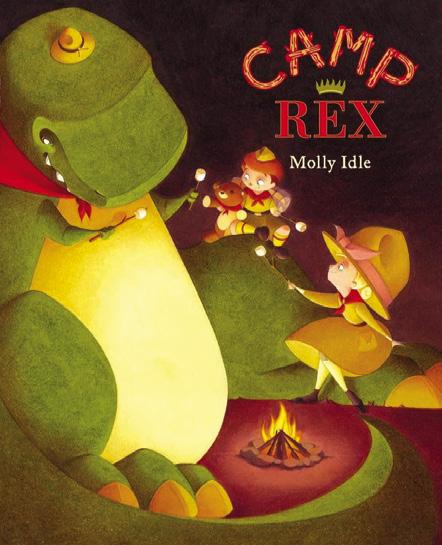
Camp Rex by Molly Idle

Camp Rex is a fun picture book to introduce your little one to what camping is all about, featuring fun illustrations of a little girl, her younger brother, and a pack of colorful dinosaur friends! While the text reads like a wilderness guidebook, with lots of great advice for venturing out in nature, the illustrations feature all the shenanigans you would expect from dinosaurs camping for the first time—like, roasting marshmallows on a spiky tail or carrying firewood with horns!
WHY YOU’LL LOVE IT: “This is the perfect picture book for anyone looking for a funny, imaginative take on camping.” -Davina N., Youth Services Supervisor
The Busy Tree by Jennifer Ward
Beautiful illustrations and brief, rhyming text take readers on a tour through the roots, bark, trunk, and branches of a tree that has a lot going on. We see up close how trees provide a place for spiders and robins to build homes, woodpeckers to find food, and kids to play in the shade.
WHY YOU’LL LOVE IT: “The simple but detailed illustrations will give adults and little ones lots to discuss while enjoying the book and to reference later while exploring the woods or the backyard. A fun way to build vocabulary and encourage an interest in nature!” - Andrea B., Library paraprofessional


Raj and the Best Vacation Ever! by Sebastien Braun
When Raj and his father embark on a camping adventure not everything goes as planned. From trouble setting up the tent to running out of water while hiking, the trip tests both Raj and his father’s perseverance. Despite the mishaps, father and son build memories together and even manage to make new friends!
WHY YOU’LL LOVE IT: “Readers will be drawn to the cute, loveable characters while the vivid illustrations add depth to the story. Once you’ve read the story, you will want to go back and look at the pictures again. Be sure to pay attention to how the backpack’s expressions change throughout the story.”
- Kim L., Library Supervisor
The Boy Who Cried Bigfoot by Scott Magoon Ben is a talented storyteller but he gets carried away with his creative skills and the neighbors get fed up.
WHY YOU’LL LOVE IT: “It’s a very funny four-minute read with cute, highly engaging illustrations, new vocabulary, and more than one wise lesson to learn.”
- Andrea B., Library paraprofessional



Peg + Cat The Camp Problem by Jennifer Oxley and Billy Aronson Peg, Cat, and their friends Aki and Richard are spending the summer together at Camp Niniwawa in the Gopher Bunk. They have to work together as a team to solve problems like feeling homesick, competing in camp challenges, and helping others.
WHY YOU’LL LOVE IT: “This book not only incorporates lessons about math and science, but is also a reminder that there are more important things than winning.”
- Lexis H., Librarian
Redwoods by Jason Chin Redwoods is a backlist gem you may have missed (published in 2009). This informational picture book is perfect for your beginning reader with its mix of fiction and nonfiction elements. We walk alongside a young boy as he learns about redwoods by embarking on an imaginative adventure through the redwood forest.
WHY YOU’LL LOVE IT: “Your child will get swept up in Chin’s illustrations using fantasy to create interest around the facts he is sharing about these amazing trees.”
- Jennifer B., Library Administrator
Lumberjanes: Unicorn Power! by Mariko Tamaki and Illustrated by Brooke Allen It’s another day at camp for the Lumberjanes, hanging out with their best friends, discovering a herd of smelly unicorns, and climbing a mysterious mountain to earn their Extraordinary Explorers medal. What could possibly go wrong?
WHY YOU’LL LOVE IT: “This is a fun read following a friend group who are all about learning, curiosity and caring for each other. Start reading for the camp and friendship, stay for the puns and unicorns!” - Lexis H., Librarian
Maker Comics: Survive in the Outdoors! By Mike Lawrence Sophia and Alonso reluctantly learn about back country survival from their abuelito, who is excited to take the two siblings fishing. When abuelito twists his ankle, their careful preparations and the skills they have learned allow them to survive and enjoy an unexpected overnight stay in the woods.
WHY YOU’LL LOVE IT: “This heart-warming graphic novel includes seven great outdoor survival projects and teaches outdoor skills in an engaging way. Kids can learn to make a buddy burner, how to fish, how to make a campfire, and see how much fun it is to be out in nature and spending time with loved ones.”- Jennifer G., Library Manager
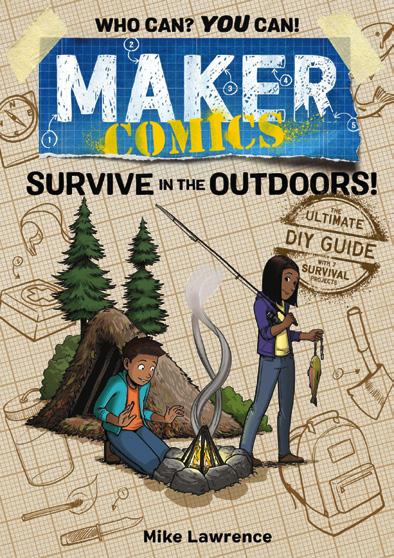

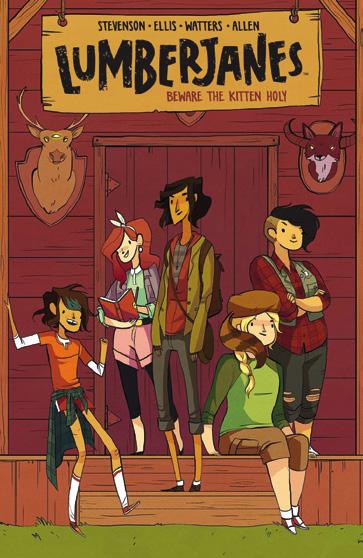
Highly Suspicious and Unfairly Cute by Talia Hibbert Bradley and Celine, once best friends, now academic rivals, find themselves competing in a wilderness survival competition for the grand prize of a full university scholarship. Forced to work as a team to survive and thrive in the forest and win their free ride to university, the two teens wrestle with their past and struggle to rebuild their trust, all while discovering their authentic selves.
WHY YOU’LL LOVE IT: “Laugh-out loud funny moments, well-developed diverse and likeable characters, and the author’s sensitive portrayal of contemporary teen life, make this YA novel a joy to read.” - Jennifer G., Library Manager
The Lumberjanes Series by ND Stevenson
This series of graphic novels features five fierce friends who meet at a camp for girls. Things start out normal enough, but before long they are fighting supernatural enemies with the help of their scouting survival skills and one another. These funny and fastpaced stories will keep you wondering at the mysteries surrounding this camp.
WHY YOU’LL LOVE IT: “This is the perfect series for anyone looking for adventure, strong female protagonists, lots of laughs, and yetis.” - Davina N., Youth Services Supervisor
BOOK PICK FOR MOMS
By Lacie Mercer • Synopsis from publisher
EMBARK ON A candid and comically insightful journey through the rollercoaster of life in "Who Else is Fine." In this compelling memoir, join Phoenix wife, pastor, and mom to two girls, Lacie Mercer, as she spills the tea on the hard-earned lessons that come with navigating the choppy waters of topics like identity, anxiety, jealousy, friendships, and the elusive pursuit of unabashed fun.

Life's too short for dull moments, and this book is your permission slip to embrace the ridiculous, relish the absurd, and revel in the joyous chaos that is being alive. So, if you've ever felt like you're the only one stumbling through the maze of life, fear not. "Who Else is Fine" is your hilarious, heartfelt guide to weathering the storm with a smile. Get ready to laugh, learn, and realize that, hey, you're not alone—because who else is fine?
BOOK PICK FOR DADS
By Rudy Montijo • Synopsis from publisher
TUCSON NATIVE, University of Arizona football alumnus, and father of two, Rudy Montijo, fearlessly dives into topics many shy away from discussing in his new book, “Mental Legacy”. Drawing from his experiences, background, and training, Montijo presents a straightforward process, "E.N.L.I.T.E.N," accessible to all. This method teaches readers how to identify mental and emotional barriers, foster accountability, and guide them toward progress.

BOOK PICK FOR MOMS
By Dr. Whitney Casares • Synopsis from publisher
DR. WHITNEY CASARES, author, pediatrician, and mother of two, shares the step-by-step plan she developed as a modern working mom to help her stop over-functioning at work and home, stop blaming herself for everything that went wrong, and start living a balanced and intentional life.
Doing It All features Dr. Whitney's complete step-by-step plan to achieving your Centered Life. Featuring powerful personal stories from real working moms, as well as quotes and interview excerpts from parenting experts, medical professionals, and mental health advocates, Doing It All meets working moms where they are, recognizes the personal and systemic challenges they face, and offers solutions that really work. It’s time to stop merely “surviving” motherhood. Join Dr. Whitney and thousands of other working moms across the country and discover the tools, systems, and support you need to parent, work, and thrive in your daily life.

BOOK PICK FOR DADS
By Larry Hagner • Synopsis from publisher
BECOMING A FATHER is one of life's most profound joys and solemn duties. In The Spirit of Fatherhood, Larry Hagner provides fellow dads the wisdom and tools to navigate one of life's most epic and awe-inspiring adventures.
Mental Legacy equips readers with the emotional and cognitive tools to overcome challenges, process trauma, and excel in various spheres of life—personally, professionally, and physically. These skills can be gifted to loved ones, leaving behind a lasting mental legacy.

As founder of "The Dad Edge," the #1 podcast about fatherhood on Apple Podcasts, Hagner makes his lessons relatable through vulnerable stories, humorous anecdotes, and refreshing honesty. You'll come away feeling empowered, equipped and deeply connected.
Whether you're counting down to your first child or already have a full house, this book offers inspiration for dads aiming to ground their families with timeless wisdom and everlasting love.





By Scarlett Bendixen, Made It Ate It Loved It
Are you needing a dangerously, fun, spooky Chex mix for Halloween? This is a perfect mummy mix that is packed with all the candy for Halloween - Reese’s, Kit Kats, and marshmallows! This mix screams Halloween, and the whole family - especially the kiddos - will be grabbing handfuls.
• 4 cups rice Chex cereal
1 cup almond bark, melted
• 2 cups powdered sugar
• 3 cups white chocolate covered pretzels
2 cups mini marshmallows
• 7.6 oz. bag white mini Resse's
• 7.6 oz. bag white mini–Kit Kats
• 1 cup shredded coconut
• 1/2 cup white chocolate chips
• 1/2 cup candy eyes
Instructions
1. In a large bowl mix together rice Chex cereal and melted almond bark gently.
2. Once Chex cereal is completely covered in almond bark, then add to a large Ziplock bag and add powdered sugar. Seal bag and shake, coating all cereal.
3. In a large bowl, add coated cereal and the remaining ingredients and toss together.
4. Serve and enjoy!
THANKSGIVING RECIPE: Pumpkin Pie Dip
Making Pumpkin Pie Dip can be super simple and only takes a few minutes to make. It is absolutely delicious paired with graham crackers, vanilla wafers, or apples, and is the perfect fall recipe for your holiday party.
Ingredients
• 1 (3.5 oz) instant vanilla pudding
• 3/4 cup pumpkin spice creamer
• 1 (7.5 oz) container pumpkin cream cheese
• 1/4 cup sugar
• 1 (8 oz) container whipped topping, slightly thawed
• Pumpkin pie spice, garnish
• Cinnamon graham crackers, vanilla wafers, etc.
Instructions
1. In a small bowl, mix together the pudding and pumpkin creamer.
2. Whisk together well and then let sit for 5 minutes.
3. In a different bowl, add the pumpkin cream cheese and sugar.



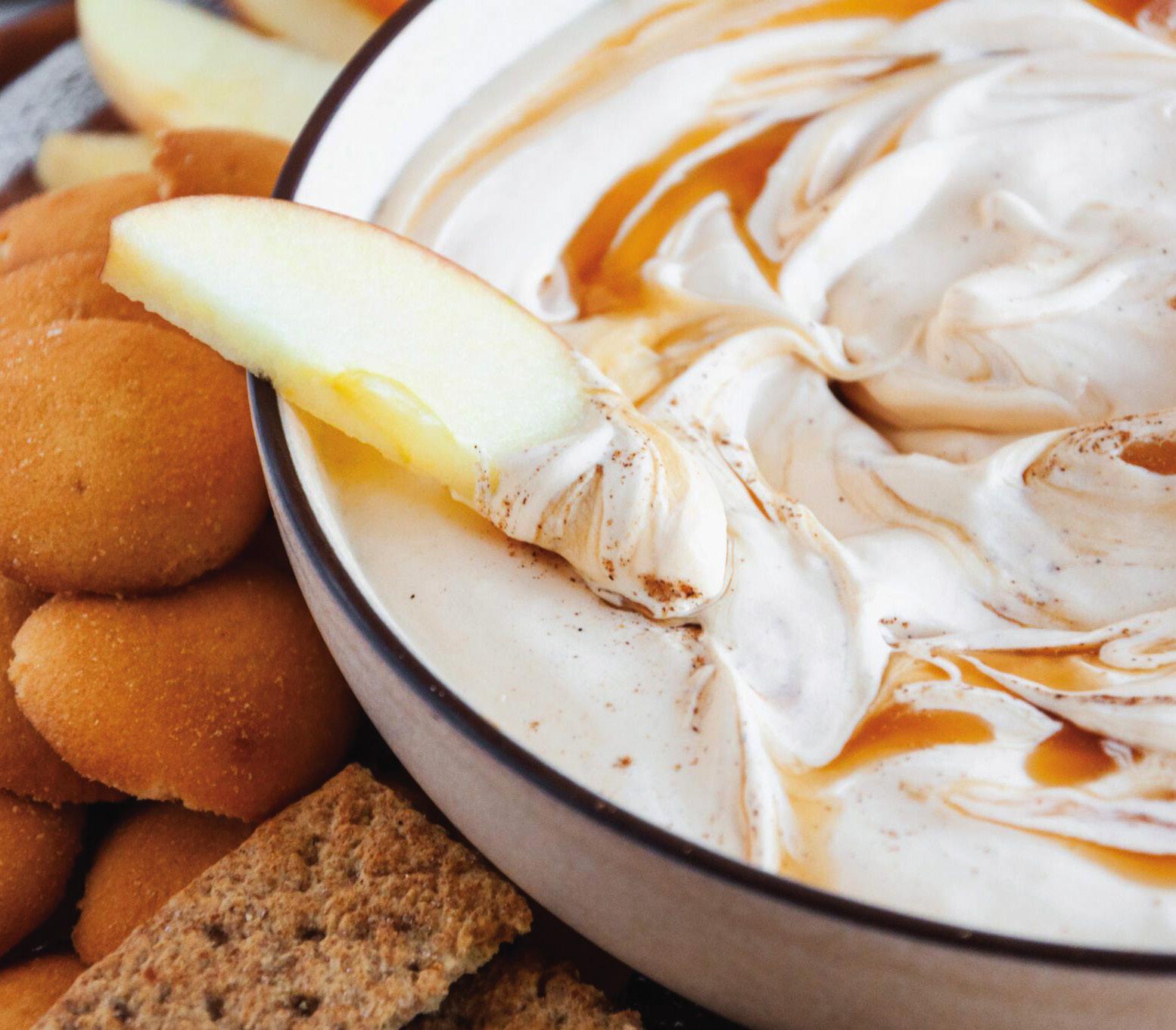
5. Once the pudding has set for 5 minutes add the pudding to the cream cheese mixture. Then fold in the whipped topping.
6. Store in the fridge.
7. Right before you serve, sprinkle with pumpkin pie spice and serve with cinnamon graham crackers, vanilla wafers, apples, etc.



By Rachel Galvez
AS A MOM of two, I know firsthand the joy of seeing my children excited for Halloween, and the challenge of balancing their excitement with budget considerations. If you're facing a similar situation, fear not! There are plenty of ways to create memorable costumes without breaking the bank. Here are some money-saving costume ideas that will keep both your kids and your budget happy.
One of the best ways to save money on Halloween costumes is to visit your local thrift stores. Thrift stores are treasure troves for unique and affordable costume pieces. With a bit of creativity, you can piece together an incredible costume for a fraction of the cost of a brand-new one. Look for basic items that can be transformed with a little imagination. For example, a simple black dress can become a witch's outfit with the addition of a hat and some makeup, or a suit jacket can be the start of a sophisticated secret agent ensemble. The possibilities and characters are endless when you think outside the box!
Another great way to save money is by creating DIY costumes using items you already have at home. This not only saves money but also encourages creativity and resourcefulness. Look around your house for inspiration. An old bedsheet can be transformed into a classic ghost costume with just a few cuts and a bit of paint. Cardboard boxes can be painted and decorated to become robots, cars, or even a wearable aquarium. The best part about DIY costumes is that they are unique and personal, and can be as elaborate as you’d like.
Costume swapping is a fun and eco-friendly way to save money. Organize a costume swap event with friends, family, or neighbors. Gather everyone’s old costumes and let the swapping begin! This is a great way to give new life to costumes that have only been worn once and to find something new for your kids without spending a dime. Plus, it’s a wonderful opportunity to build community and share in the excitement of Halloween together.
Here are a few budget-friendly costume ideas to get you started:

• Scarecrow: Use old jeans, a plaid shirt, and a straw hat. Stuff some straw or fabric scraps in the sleeves and collar for a rustic look.
• Pirate: Use an old striped shirt, a bandana, and some black pants. Add a homemade eye patch and a cardboard sword.
• Superhero: Use your child’s favorite superhero t-shirt and leggings, add a homemade cape from an old sheet, and create a mask from cardboard and elastic.
Arizona Financial Credit Union encourages smart spending habits year-round, and Halloween costumes are no exception. By thinking creatively and utilizing resources you already have, you can create amazing costumes that your kids will love!
By Rachel Galvez

THANKSGIVING IS A time for family, friends, and, of course, delicious food. But if you’ve ever hosted, you know the costs add up quickly. Luckily, there are plenty of ways to celebrate with your loved ones without overspending. Here are some tips to help you host a memorable Thanksgiving on a budget.
One of the first decisions to make is what to cook from scratch and what to purchase ready-made. Homemade dishes not only add a personal touch but can also be more costeffective. Making your own mashed potatoes, stuffing, and cranberry sauce can save money and be prepared in advance. On the other hand, buying pre-made items that are time-consuming or tricky - like pies and bread rolls - can save you time and stress. Finding the right balance will help you save both time and money.
Planning ahead and shopping smart can significantly cut down your expenses. Start by comparing prices at different grocery stores. Many stores offer special promotions
on Thanksgiving staples. Use coupons and don’t forget to check for price-matching opportunities. Buying in bulk for nonperishable items is another great way to save! Remember, it’s not just about the turkeyvegetables, drinks, and desserts can add up, so look for deals across the board.
Hosting a potluck-style Thanksgiving is another excellent way to save money. Encourage your guests to bring their favorite dish. This not only spreads the cost, but also adds variety to the meal. Assign different types of dishes to ensure a balanced spread. For example, one family could bring a side dish, another a dessert, and someone else could handle the drinks. Potlucks create a sense of community and lighten the financial load for the host.
When it comes to hosting, it’s easy to go overboard with food, decor, and table settings. To keep costs down, focus on essentials, and get creative with what you already have. For
food, prioritize dishes that everyone loves, and avoid over-preparing - leftovers are great, but excessive waste is not.
For decor, consider DIY projects using natural elements like leaves, pinecones, and pumpkins, which can be both beautiful and inexpensive. Use items from around the house; for example, a simple white tablecloth can be dressed up with a few colorful accents. Thrift stores are great places to find unique and affordable decorations and table settings. Making smart financial decisions during the holiday season is key because these times should be about enjoying moments with loved ones, not worrying about overspending. You can host Thanksgiving on a budget with some thoughtful planning and creativity, creating a warm and memorable celebration without stretching your wallet.
Rachel Galvez is the Marketing Partnerships Manager at Arizona Financial Credit Union. A wife and mom of two, Rachel is committed to empowering families with the information they need to make smart financial decisions now and set their children on the path to financial success in the future.

By Monique Seleen
IF YOU’RE ANYTHING like me, trying to decide what to feed your little one every day can be exhausting. My husband and I attempt to prep a few quick meals for our 2-yearold son each week, but if we’ve had a busy weekend or have been out of town, it doesn’t always happen.
This was why I was so excited to find out about Tiny Plates – healthy, locally made meals designed just for kids and delivered right to your doorstep.
Owner, Jessi Lupardo, got the idea to start Tiny Plates after she and her husband were feeling pressured to spend hours every week planning, prepping, and making healthy, yummy meals for their son, and then feeling guilty if they didn’t succeed.
“My husband travels frequently for work, and I’m a small business owner of a local bakery,” said Lupardo. “I frequently used meal delivery companies to help fill the gaps around mealtime. The meal delivery services were helpful, but not necessarily kid-friendly.”
As a result, Lupardo began thinking up the idea for Tiny Plates, developing recipes and enlisting the help of many tiny taste testers. Eventually, Tiny Plates made its first deliveries in March 2024.

Tiny Plates offers a varied menu of flavorful, well-balanced, thoughtfully portioned meals for toddlers and kids.
Each plate contains:
• Protein
• Fiber
• Healthy fats
• Fruits and Veggies
• And something fun (and still healthy)!
“Our goal is to create a balanced meal with at least 9 grams of protein and 4 grams of fiber,” said Lupardo. “Our meals are prepared entirely with Certified Organic meats, dairy, and eggs, and we only use organic olive and avocado oils in our cooking. Even our snack cakes are a component you can feel good about!”
The menu offers a set of customer favorites that never change such as the hidden cauliflower mac and cheese, teriyaki bowls, and pizza wheels. But, to keep things fresh, each week you’ll also see one or two new adventurous meals added.
There’s no subscription necessary and no minimum amount needed—just order the meals you want on the weeks where you could use a little extra help!
Place your order by noon on Thursday, and meals will be delivered to your home on Monday afternoon between 5 p.m. and 8 p.m.
All meals come in an insulated bag with ice packs – included in the $12 flat delivery charge, and will be left on your doorstep with a text to alert you of its arrival.
When its meal time, simply place the Heat-to-Eat Plates in the microwave for a meal ready in 1 minute, or place them in an ovensafe container and heat them in the oven.
The Lunchbox-Ready Plates can be enjoyed cold, and the yogurt drinks can be savored right from the fridge with no prep at all.
My son absolutely devoured the meals we got to try, and it was such a load off my plate not having to think about what I was going to make him for breakfast or lunch that day.
Tiny Plates’ meals are perfect for busy school nights, to take with you on vacations, or pack in your child’s lunchbox.
For more information on delivery radius, or to place an order, visit tinyplates. com . Use code RaisingAzKids 20 for 20 % off your first order!

BRAND NEW CAMPUS:
Great Hearts Catalyst (K-8) near 67th Ave. & Indian School
Great Hearts Christos Gilbert (K-6) near Downtown Gilbert



By Monique Seleen
MY FAMILY AND I recently moved into a new house, and one of the things we were most excited for was creating a playroom space for our 2-yearold son.
For the past few months, I’ve been intentionally transforming our loft into a playroom that is not only engaging and fun for my son, but a well-organized and functional space that keeps my sanity intact, too.
Here are some of our favorite must-have items:
A good playroom will likely have lots of pretend and imaginary play items, promoting creativity and learning. Here are a few pretend play items we’ve recently added and love:
1. Melissa & Doug Thirst Quencher Drink Dispenser
This allows kids to make their own juice cups, and fill them with plastic ice cubes with a push of a lever. Perfect add on to any play kitchen! $39.99. melissaanddoug.com
2. Little Tikes First Fridge
This play fridge is packed with interactive features including a working ‘ice’ dispenser, dual French doors, a separate freezer drawer, and working fridge lights. Plus, it makes realistic sounds! $50.99 littletikes.com
3. Melissa & Doug Pop-up tent
Melissa & Doug pop-up play tents create a fun indoor playhouse-like structure that collapse and store away easily. Choose from several designs including the Fire Truck, Food Truck, Cozy Cottage, and more. $47.99 – $64.99. melissaanddoug.com
4. Melissa & Doug Costumes
My son is just starting to get into dress up play so we got him the Fire Chief costume to go with his Fire Truck tent. Melissa & Doug have several other costumes including a doctor, chef, construction worker, veterinarian, police officer, and more! $37.99. melissaanddoug.com
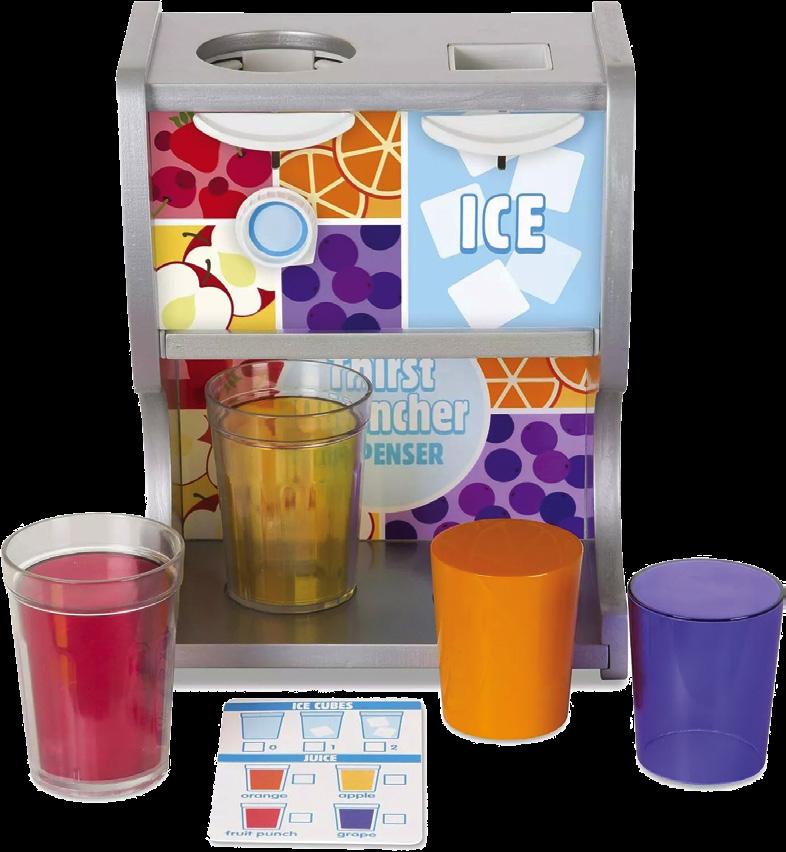






I like finding furniture that is both kid-friendly and functional. Here are a few of my must-have recommendations for storage and organization.
5. Deluxe Learn ‘N Play Art Center Easel
The Deluxe Learn ‘N Play Art Center Easel features a chalkboard, magnetic dry erase board, and paper feeder. I love how many different uses it provides. We have alphabet magnets on it right now as my son learns letters. $149.99. littlepartners.com
6. IKEA Bergig Book Display
This book case has two open shelves to display books, and a spacious drawer for storage. I love that it’s a perfect height for little ones allowing them to reach for their own books. Plus, the storage drawer is huge, and offers a great place for us to store any books that aren’t in use. $129.99. ikea.com
7. IKEA Trofast Storage
This sturdy wooden storage unit has lightweight plastic boxes that kids can easily slide out, carry and put back again. It’s perfect for storing any loose toys such as Legos, Magna-tiles, or puzzles. $19.99 – $103.99. ikea.com


If you’ve got some rambunctious kids, having some items in your playroom to actively move and get energy out is a must. Here are a couple active play items I love:
8. Little Tikes 2-in-1 Indoor-Outdoor slide
This slide is perfect for toddlers to learn on. It can be used indoors as a regular slide, or taken outdoors and hooked up to a hose where water will spray through its jets. It also folds up easily when not in use. $49.99. .littletikes.com
9. Little Tikes Ride On Toy: Dirt Digger Garbage Scoot
If you’ve got toddlers, having a ride on toy is a must! Little Tikes has tons of options to choose from such as electrically powered vehicles, push cars, and more. My garbage-truck-loving son absolutely adores the Dirt Digger Garbage Scoot and pretending like he’s a garbage man! $49.99. .littletikes.com






By Melissa Leon
TAXES MAY NOT be the most exciting topic, but teaching your teens about taxes can empower them to understand how their money is spent and used both personally and at the government level.
Taxes provide essential revenue for federal and local governments, funding public services such as:
• Defense (military and national guard)
• Police
• Justice systems
• Public Education
• Roads
• Emergency services like firefighters
• Public libraries and parks
When teens understand why we pay taxes, they can appreciate the vital role taxes play in maintaining the services and infrastructure we rely on daily.
The concept of taxes can be complicated and daunting, but breaking it down into the most common types can make it more manageable. Here are the key types of taxes teens should understand:
• Sales Tax: Sales tax is typically a percentage of the purchase price added to the final cost. For example, when you buy
a shirt, you don’t just pay the price of the shirt; you also pay the sales tax for the city where you purchased it.
• Federal Income Tax: Federal income tax is a percentage of a person’s income. For employees, the amount is deducted from their paycheck and sent to the federal government by the employer.
• State Income Tax: Similar to federal income tax, but the money is sent to the state government. As of 2024, nine U.S. states do not charge state income tax.
• FICA (Federal Insurance Contributions Act): FICA taxes are for Social Security and Medicare, deducted from both employees and employers. These funds are collected over a person’s working life and are payable upon retirement.
• Property Tax: Property tax is levied on property owners and sometimes included in lease agreements. The rate depends on the county, type of property, and its uses.
Understanding taxes can be easier with practical, real-life examples:
• Sales Tax: When you take your child to the store, let them pick out an item between $1 and $5. Give them money to pay for it in cash and show them on the
receipt how much was charged for taxes. This hands-on experience helps them see how sales tax works.
• Income and FICA Tax: Show your child your pay stub and explain how much is taken out for taxes. Discuss the different types of taxes and what the government uses the money for. This can help prepare them for when they start paying taxes from their first job or business venture.
The key to teaching taxes is simply talking about it. Neither you nor your teen need to be tax experts, but having a basic understanding of why and how we pay taxes will set them up for long-term financial success.
Remember, taxes are complicated and everchanging, so it’s okay not to know everything. If you have specific tax questions, it’s best to consult a licensed professional.
Melissa Leon is a Tucson native, NAU graduate, and Mesa resident. She co-owns Two Sense Consulting, a bookkeeping and fractional CFO firm dedicated to helping small business owners learn to read and make decisions based on financial statements. She is also the best-selling author and podcast host of “Efficiency Bitch, How Ambitious Women Can Have It All Without Doing It All”. Melissa is a mother of three children.




By Michael Klinkner
RAISING TEENAGERS often involves having challenging conversations, but addressing these topics openly, honestly, and effectively is crucial for safety and well-being. Below is a guide on how to talk to your teens about underage drinking, drug use/vaping, peer pressure, safe sex and abusive relationships:
• Start early and stay involved: Ideally, initiate a conversation about alcohol before your teen starts middle school. Use teachable moments to discuss the risks and consequences of underage drinking.
• Provide clear information: Explain how alcohol affects the developing brain and body. Highlight the legal consequences and potential long-term impacts.
• Set clear expectations: Communicate your family’s rules regarding alcohol use and the consequences of breaking them. Make sure your teen understands your stance on drinking and knows they can call you for help without fear of immediate punishment if they find themselves in a risky situation.
• Encourage open dialogue: Foster an environment in which your teen feels comfortable discussing their experiences and the pressures they face regarding alcohol. Listen without judgment and provide guidance based on their input.
• Educate yourself and your teen: Stay informed about the different substances teens might encounter, including marijuana, other drugs, and vaping

their experiences with you. They probably know more than you do about the current drug climate.
• Discuss the risks: Explain the short-term and long-term health risks associated with drug use and vaping. Include the potential for addiction and its impact on their future goals and aspirations.
• Talk about parties: Discuss ways friends and social circles can influence drug use. Help your teen develop strategies for saying no and exiting situations where drugs are present.
• Be a role model: Demonstrate healthy behaviors and coping mechanisms. Share stories of individuals who have faced consequences due to drug use, and have your teens share stories with you. Use the stories to emphasize the importance of making healthy choices.
• Define peer pressure: Help your teen understand what peer pressure is and how
it can show up in different situations, from trying substances to engaging in risky behaviors. Have your teen share times they have seen it themselves or with friends and acquaintances.
• Encourage independence: Support your teen in developing their own values and decision-making skills. Reinforce the idea that it’s okay to stand out and make different choices than their peers.
• Be supportive: Let your teen know you’re there to support them, no matter what. Praise their efforts to resist peer pressure and make healthy decisions.
• Start early and be open: Begin discussions about sex and relationships around the time your child enters junior high. If you’ve never had these conversations, it will be awkward at first. But these aren’t one-time interactions. It will get easier the more often you do it.
• Provide accurate information: Ensure your teen understands the basics of safe sex, including contraception, sexually transmitted infections (STIs), and consent. Have an open and honest discussion about consent and provide additional information if needed.
• Discuss values and respect: Talk about the emotional aspects of sex and relationships. Encourage them to respect their boundaries and those of their partners.
• Be approachable: Make it clear that they can come to you with questions or concerns about sex without fear of judgment or punishment.
• Educate your teen about healthy relationships: Explain what constitutes a healthy relationship versus an abusive one. Discuss the signs of emotional, physical, and verbal abuse. Have your teen tell you about toxic relationships they have seen with peers. Remind them that abusive relationships can be romantic or friendship-based.
• Encourage self-worth: Help your teen build self-esteem and understand that they deserve to be treated with respect and kindness.
• Provide resources: Share information about where they can get help if they or a friend are in an abusive relationship. This can include school counselors, hotlines and trusted adults.
• Foster open communication: Encourage your teen to talk about their relationships and any concerns they might have. Be supportive and listen without judgment.
Talking to teens about underage drinking, drug use/vaping, peer pressure, safe sex and abusive relationships can be daunting, but it is essential for their development and safety. By approaching these conversations with honesty, empathy and clear information, parents can help their teens make informed, healthy choices. Building a foundation of trust and open communication ensures teens feel supported and understood as they navigate these tricky issues.
Michael Klinkner is a licensed clinical social worker with more than 25 years of experience working with parenting, child and teen issues. His expertise includes behavioral problems, ADHD, anxiety, depression and trauma. For more information, visit klinknercounseling.com

By Michael Klinkner
AS CHILDREN transition into their teenage years, they naturally seek greater independence and social interaction with friends. Here’s a guide to help parents and teens navigate these milestones while maintaining safety and open communication during the Halloween season:
• Establish trust and communication: Encourage your teens to share their plans, who they will be with, and where they will go.
• Set clear boundaries: Agree on curfews, transportation arrangements, and check-in times before your child leaves home. Make sure your teen understands the consequences of breaking these agreements.
• Equip teens with safety tools: Ensure your teen has a fully charged phone, and knows how to reach you at all times. Discuss the importance of staying in groups, avoiding isolated areas, and trusting their instincts.
• Discuss peer pressure: Prepare your teen to handle peer pressure by discussing scenarios they may encounter.
• Know the details beforehand: Know the host, location, and whether adults will be present. Discuss the event’s start and end times, and ensure there’s a plan for safe transportation to and from the party.
• Establish rules and expectations: Clearly outline what behavior is acceptable and what isn’t. Discuss topics like alcohol, drugs, and other
risky behaviors. Make sure your teen understands the importance of staying with friends and having a plan to leave if they feel unsafe.
• Create an exit plan: Make sure your teen knows they can call you at any time if they need to leave. Establish a code word they can use if they need to be picked up. If your teen is drunk or high, wait until the next morning to calmly get details and talk through what happened.
• Follow up: After the party, have a debriefing session. Ask your teen what they enjoyed, if there were any uncomfortable moments and - most importantly - how they handled them.
“Sexy” Costumes
• Open the dialogue: If your teen expresses a desire to wear a “sexy” costume, understand why they want to wear it and discuss the message it might send.
• Discuss appropriate choices: Discuss the difference between expressing themselves and dressing in a way that could attract unwanted attention. Help them find a balance that satisfies their desire for selfexpression and fitting in with peers while being mindful of your expectations and overall safety.
• Set limits: If necessary, set clear boundaries about what is and isn’t acceptable for your teen. Explain your reasoning, focusing on safety and respect rather than simply imposing rules.
• Offer alternatives: Help your teen come up with creative costume ideas that allow them to feel confident and stylish without being overly revealing.


PARENTS USUALLY BELIEVE that their son or daughter deserves the best possible spouse. Haven’t we all heard, “No one is ever good enough for our child”? It is their choice regardless whom they pick for a lifetime partner, unless it is in arranged marriage.
There may be religious, cultural, gender, financial, and educational differences. The most important “mindset” is to open your heart/mind by embracing a new member of your family. This will make your son/daughter’s life easier to live without judgement attached to it.
We must learn to respect our adult child for the choices they make, and remember they are living in a different time than when we grew up. Our values, beliefs, and lifestyle can be totally different from theirs, and we must respect them without criticizing or stating what we did differently.
SOME GUIDELINES TO HELP:
Make an effor t to really get to know your in-law, ask questions about their upbringing, school, family rituals, birthdays, holidays, trips they took, and their relatives (dad, mom, sister, cousins). Take time out to be alone with them or do something they like to do (go to lunch, a sporting event, shopping, etc.)
Put your ego aside. Although you are older and more experienced, try not to judge,
By Linda Levin
criticize, or tell them what to do. Respect the differences and learn about their belief system, values, or religious and cultural upbringing.
Volunteer your time. Ask your in-law/family member if they need anything while you’re shopping, running errands, etc. If they work a lot, offer to help with laundry, yard-work, or even bringing over a meal. If they have children, try to help them periodically so they can have a date night out and you can have special time with your grandchildren alone. If you can financially afford to help them, maybe offer lessons, extra-curricular activities from school, starting a college fund, etc.
Stop comparing. We may have had a different lifestyle than the in-laws. Try to be respectful of their family choices and value systems. Learn to accept the differences and share yours with them (sharing a holiday, a ritual, cultural experience, etc.).
Show respect/validation. If your in-law does something well, such as getting a bonus with their job, starting a new position, going back to college, or contributing by doing extra at the home, then congratulate them and validate their work and efforts. Tell them how proud you are of them. These affirmations will go a long way. Practice affirmations and
send them good will.
Be authentic. Be yourself and share your knowledge, wisdom, and experience about topics that you are skilled in (cooking, painting, law, health, travel, sports, etc.). Let your in-laws know about you and your past as well. Share experiences that were successful as well as failures. This will open the door of communication and authenticity.
Stay in touch. Try to remember birthdays, anniversaries, holidays, milestones, etc. Send cards, texts, FaceTime, and even send certificates for dinner, events and more.
If you have grandkids, ask about updated information on school, activities, their hobbies and their interests. If possible, go visit and take them away for a night to allow for time to reconnect. Keep things joyous and not dramatic and argumentative.
Linda Levin has a dual master's degree in education and psychology. She is married and a mother of two daughters and five grandchildren. She has been a child and family therapist and educational therapist for over four decades. Linda has taught courses in parenting, education, and psychology for various universities, hospitals, and clinics, as well as developed numerous training programs. Linda is a published author of three educational and psychological books.



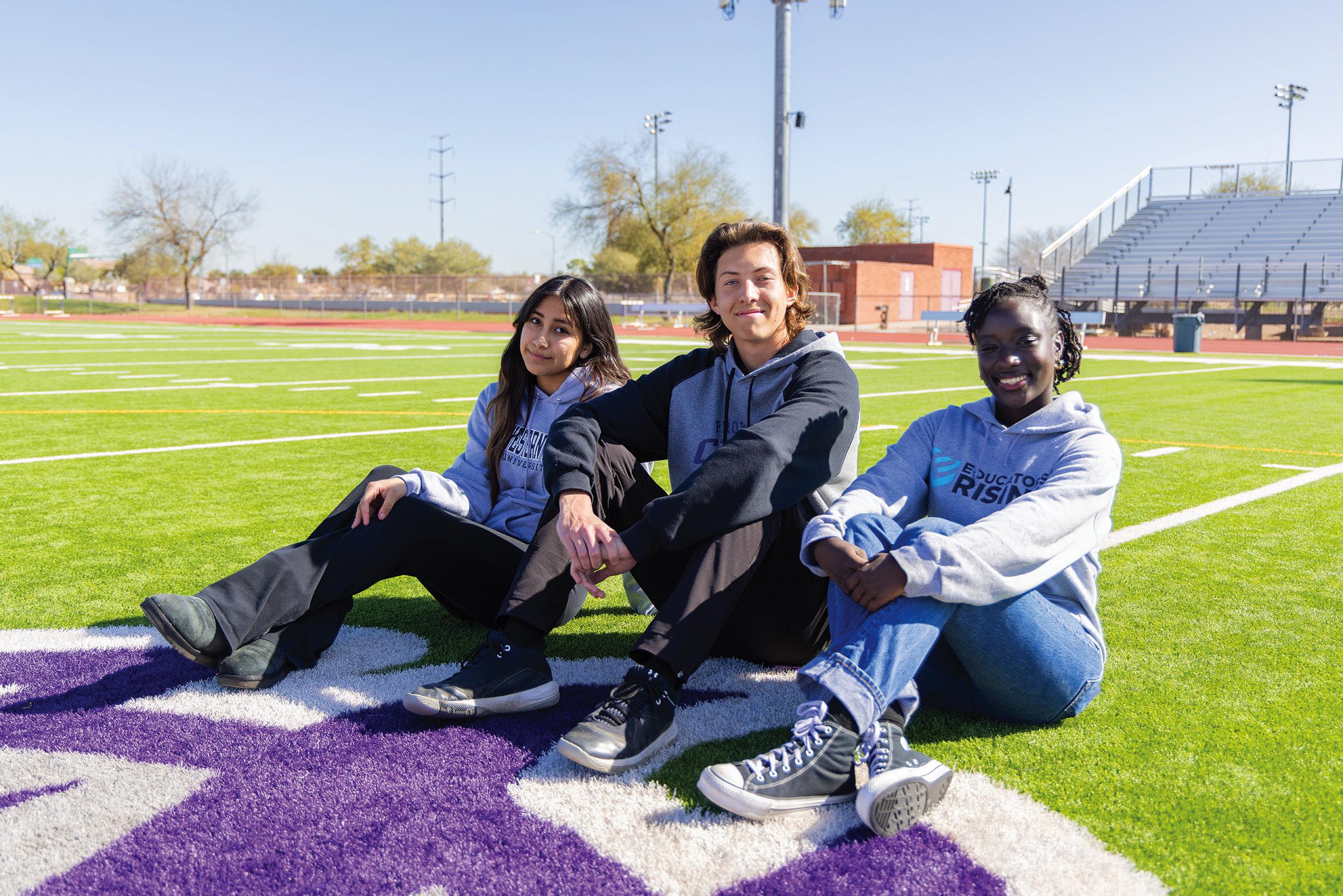


By City of Scottsdale Fire Department

IN THE HUSTLE and bustle of daily life, it’s easy to overlook household safety precautions. Yet, one of the simplest and most effective ways to protect your family is ensuring your home is equipped with working smoke alarms. These devices, though small and often underestimated, play a pivotal role in fire safety, providing crucial early warnings that can mean the difference between life and death.
Smoke alarms are designed to detect smoke, the primary indicator of a fire. When functioning correctly, they provide an audible alert that can awaken and alert household members, giving them precious time to evacuate. According to the National Fire Protection Association, three out of five home fire deaths occur in properties without working smoke alarms.
Fire departments and prevention agencies have come together with the NFPA to support this year’s Fire Prevention WeekTM theme, “Smoke Alarms: Make them work for you!” The message reinforces the critical importance of smoke alarms and what’s needed to install, test and maintain them properly.
To maximize their effectiveness, smoke alarms should be installed on every level of your home, including the basement. Place alarms inside each bedroom and outside sleeping areas to ensure they are heard by all family members. In larger homes, additional alarms may be necessary to cover the entire area adequately.
Regular maintenance of smoke alarms is equally important. Test your alarms monthly by pressing the test button and replace the batteries once a year (unless lithium batteries which can last longer). Replace the entire smoke alarm unit every 10 years or according to the manufacturer’s instructions, as sensors can lose sensitivity over time.
Beyond smoke alarms, implementing broader fire safety measures can further protect your home and loved ones. Here are some essential tips:
Create and Practice an Escape Plan: Develop a fire escape plan that includes at least two ways out of every room. Practice this
To learn more about how smoke alarms and other fire safety tips, visit ScottsdaleFD.com or AFBEA.org
Fire Prevention Week resources for children, caregivers, and educators can be found at FPW.org , S parky.org , and S parkySchoolHouse.org


plan with your family at least twice a year to ensure everyone knows what to do in case of an emergency.
Educate Your Family: Teach your children about the dangers of fire and the importance of smoke alarms. Ensure they understand the sound of the alarm and know to exit the home immediately if it goes off.
Use Appliances Safely: Avoid overloading electrical outlets and unplug appliances when not in use. Ensure that heating equipment is maintained and used according to the manufacturer’s instructions.
Preventative Measures: Regularly check for potential fire hazards such as frayed wires, cluttered areas, and unattended candles or stoves.



• Preschool - 12th Grade
• 16 schools located in Gilbert & Queen Creek
• FREE bus transportation
• Online learning available 7-12th grade


• Spanish and Mandarin Dual Language Immersion Programs (starting in preschool)
• Gifted and accelerated learning options
• FREE all day kindergarten
• 35+ Advanced placement and dual enrollment classes
• 20+ Career and technical education high school courses


By Arizona Department of Education STOP-IT Task Force

"HEY, YOU'RE A doctor. Do you know what this is?" a fellow mom inquired as she thrust a small yellow pill into my palm. "Where did you find this?" I asked, examining the pill. "I didn't. My 4-year-old daughter did in the classroom," she responded. "She picked it up off the ground and hid it in her cubby all day." Upon examination, this particular pill appeared to be a vitamin. But its potential to have been something much more sinister left us both shaken. Our children were safe...for now. Some kids aren't so lucky.
The topic of opioid overdoses makes the news almost nightly. Our proximity to the Mexico border lends Arizona to be the largest state trafficker of illicitly-produced fentanyl in the nation. An opioid typically used to manage severe pain, it is illegally synthesized by drug cartels to entice, entangle, and harm our most vulnerable populations. Fentanyl is also a common and elusive co-contaminant of other drugs and deceptively formulated to impersonate popular candies, such as Smarties or Skittles. These pills, designed to trick an unsuspecting consumer (a child, for example), contain a dose of fentanyl capable of killing the average American adult in 70% of cases. These synthetic pills are readily accessible to our youth via social media avenues such as
Tik Tok and Snapchat. In fact, our children are their targets. The Arizona Child Fatality Review Program estimated at least 80 deaths due to opioids between 2021 and 2022 and 132 overdose events in 2023 alone. And with no state requirements for overdoses on school campuses to be centrally reported, these numbers are likely underestimates.
So, what is a parent to do?
I confess, the classroom incident left me feeling uneasy. My professional expertise was toe-to-toe with my maternal instincts. I knew too much. And our children know too little. What, when and where could they learn the hard facts of this epidemic without learning the hard way?
Thanks to a new taskforce formed in partnership with the Arizona Department of Education, these questions are being answered. The School Training and Overdose Preparedness Intelligence Taskforce (STOP-IT) initiated in May 2024 with the purpose of ensuring every Arizona kid is educated on the dangers of synthetic opioids and staff are trained on how to use the life-saving opioidoverdose medication, naloxone.
The taskforce is comprised of a diverse group of carefully-selected experts in the
fields of medicine, education, government and behavioral health. From superintendents, to school counselors, to physicians, to drug intelligence officers, parents and even students, members have assumed a gargantuan undertaking: end opioid overdose deaths and prevent addiction in our kids. The more than 60 members serve on a curated list of subcommittees dedicated to tackling all aspects of the opioid crisis in schools. This includes ensuring staff and students have naloxone available in all educational buildings, creating policies and procedures for school districts to adapt so staff can administer the drug and train on it, developing a statewide school survey to understand barriers to naloxone use and building a statewide overdose reporting system to make sure school overdoses are tracked at a state level. But rising to the top of their to-do list is ensuring students and staff receive standardized, impactful training on the dangers of the illicit drug trade and how to recognize its consequences.
Already primed to see movement on this topic and well-versed in the worlds of medical school education and healthcare quality, I was thrilled to join the taskforce as the Chair of the Best Practices for Staff and Student Education STOP-IT initiative.
There is no shortage of work ahead of us. The subcommittee is already hard at work meeting with national and local experts and examining existing curriculum to develop a best training practice. The subcommittee has identified curriculum ‘must-haves’, such as ensuring age-appropriate (6th through 12th grade) content, being culturally sensitive, existing in a modular electronic format with no in-person training requirements, proving cost-effective and easy to implement. Most importantly, the curriculum must incorporate a host of trackable metrics that can monitor student engagement, product satisfaction and ultimately impact on overdose rates. To keep the content relevant, discussions on including social media influencers to promote STOPIT’s message are also in the works.
With taskforce meetings well underway and a statewide survey evaluating the status of naloxone preparedness in Arizona schools in the hands of more than 2000 school leaders, we are beginning to understand the current state of the state. The taskforce has a robust timeline with plans to employ curriculum in early 2025.
If you are reading this article, you are likely an engaged, Arizonan parent. That makes this topic deeply personal. The opioid epidemic is now endemic and the drugs are equal opportunity destroyers. Assumptions that overdoses only happen to “bad” kids who buy and sell drugs is a gross misunderstanding of current state and a misinterpretation of the science that drives addiction. The real epidemic is about the 12-year-old who goes on Tik Tok looking for a pill to help concentrate for an upcoming test and overdoses on a sadistic counterfeit. It’s about the child looking for social acceptance who falls quickly into peer pressure and quicker out of consciousness. It’s about kids just like yours.
The first step is to get educated! The book ‘Ending the Crisis: Mayo Clinic’s Guide to Opioid Addiction and Safe Opioid Use’ is an excellent resource to help both young adults and parents understand now to navigate the opioid crisis. Readers will learn:
• How prescribed opioids differ from street drugs
• How opioids change the brain to cause addiction
• Ways to prevent, identify and manage an opioid overdose
• Evidence-based, successful treatments for opioid addiction

• The role of boundaries, interventions and communication in opioid addiction
• Much more!
The book is filled with engaging, heartfelt testimonials of people who have lived the opioid epidemic and offers hope to readers.
Parents, we need your help. These are our children. Let’s take them back. Remember, it’s never too early to start talking to your kids about drug safety. Kids who have these conversations with their parents are 40-50% less likely to use drugs. And keep the conversation going. You can’t overcommunicate the dangers of drug use in 2024. As parents, we need to step up, speak out and take back what’s ours. It’s time to break the drug trade’s grip on our children’s future. It’s time to STOP-IT.

For more information, please contact schoolsafetysocialwellness@azed.gov or visit azed.gov/stopit.
• Krystal Renszel, DO, MS, FACP, Chair, Student and Staff Training Subcommittee, STOP-IT Task Force
• Holly Geyer, MD, FASAM, Chair, STOP-IT Task Force
• Mike Kurtenbach, Co-Chair, STOP-IT Task Force
Resources:
• Song for Charlie: Real Talk About Fake Pills (songforcharlie.org)
• Natural High: Fentanyl Toolkit - Information and Resources on Fentanyl (naturalhigh.org)
• Drug Enforcement Agency Operation Prevention: Opioid and Prescription Drugs (operationprevention.com)
• Sold Out Youth Foundation (soldouttv.com/bio)
• DEA: One Pill Can Kill (DEA.gov)
• Community Bridges (communitybridgesinc.org)

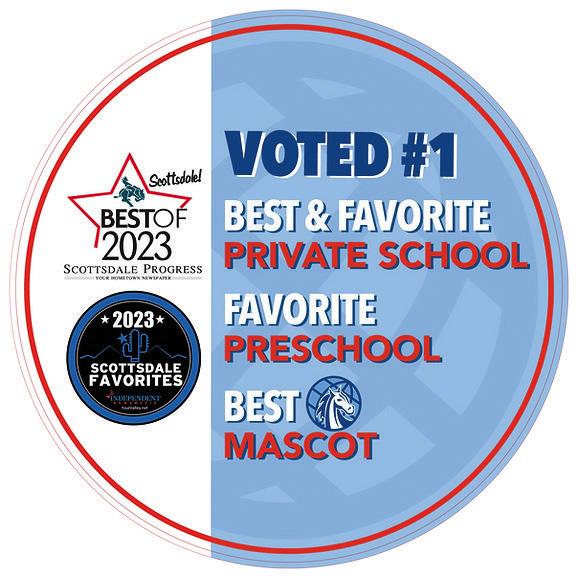

French & Spanish Language Immersion Programs PK1 (18 Months) – Grade 8
International Program No Prior French or Spanish Experience Needed. Grades 6 – 7
APPLY TODAY — SPACE IS LIMITED! NOW ENROLLING STUDENTS THROUGH MARCH. Schedule a Campus Tour or a Shadow Day for Your Child!
International School of Arizona 480.874.2326 | ISAZ.org | Admissions@ISAZ.org 9522 E San Salvador Dr, Scottsdale, AZ 85258



By San Tan Charter School
ONE OF THE best things a school can do is equip students with hands-on and real world knowledge that they can use throughout their entire lives.
Thanks to an on-going partnership with Junior Achievement, students from San Tan Charter School in Gilbert are experiencing just that.
As Carol Berhost, Junior Achievement Coordinator for San Tan Charter School’s elementary campus noted, volunteers from Junior Achievement regularly visit the school to lead activities and hands-on lessons that cover “real world” topics including how to write a check, make a deposit at a bank, create a budget and more.
Students from kindergarten through middle school take part in the fun and
engaging lessons, which are tailored to the age of the students.
For example, noted Anne Landers, Chief Operating Officer for Junior Achievement of Arizona, a lesson on money is explained to kindergarteners in a different way than to a group of fourth graders.
“At the younger ages, Junior Achievement is helping learners understand fundamental concepts like needs versus wants, about money and why it exists, and how it moves through the community to meet our needs,” Landers said.
“At older ages, students are learning far more complicated concepts like family budgets, opportunities and obstacles, credit versus debit and investment opportunities. Through each age group, there is a reinforcement of how learning correlates
to earning and the long-term value of educational pathways to future careers.
Megan Hubbard, who leads the Junior Achievement program for the middle schoolers at San Tan Charter School, said the hands-on lessons about finances and other topics have definitely made a positive impact with students.
“They have a deeper understanding of finances, from the ground up. They understand the community aspect of money as well, which I think will be a concept that sticks with them,” Hubbard said.
“They know how to write a check, figure out sales tax, make a deposit at a bank – real world skills that many kids have to figure out on their own when they turn 18.”
San Tan Charter School has also been able
to apply the concepts learned in the Junior Achievement lessons to its Montessori adolescent program for seventh and eighth graders.
As Hubbard noted, a cornerstone of the curriculum is the establishment of studentled small businesses, collectively known as a microeconomy. Central to the microeconomy process is the integration of Junior Achievement skills, she said.
“Over the past year, our students have successfully managed three enterprises: our Go Green farmer’s market, a ‘Parents’ Night Out’ service, and a coffee shop catering to teachers. These microeconomy ventures offer invaluable real-world experience, giving adolescents practical skills in business operations, teamwork, and community engagement,” Hubbard said.
“Also, through JA’s JABizTown and JAFinance Park programs, our students have gained essential knowledge in managing a business budget, understanding taxes, and recognizing the risks inherent in any business. They also explored career interests and developed an appreciation for economic independence.”
By applying these JA skills in their microeconomy ventures, students are not only preparing for future professional challenges but also building a foundation for lifelong success.
This year, San Tan Charter School will host a JA Day. On September 24, JA volunteers will spend the day teaching three to four lessons to one classroom of students. Training sessions for new JA volunteers will take place in person from 4-4:45 p.m. on Thursday, August 22 and online from 4-4:45 p.m. on Thursday, August 29.
During the last three school years, 1,322 people who live or work in Gilbert volunteered with Junior Achievement. Homeschooled students are also welcome to participate in Junior Achievement programs.
“We have tons of opportunities to volunteer with JA - in fact, it takes nearly 8,000 volunteers to deliver our programs each year,” Landers said.
To learn more about the training session for new JA volunteers at San Tan Charter School, and/or to sign up, please email Carol Berhost at carol.berhost@ santancs.com
To learn more about Junior Achievement and/or get involved and support its mission through time, talents or treasures, please visit jaaz.org








By BASIS Charter Schools
YOU MAY HAVE noticed that many schools in Arizona offer both full-day and half-day options for kindergarten.
That’s because in Arizona, full-day kindergarten is not a requirement. According to state law, schools must provide a half-day kindergarten option for families, but it’s up to each individual school district whether or not they offer a full-day option.
Even though full-day kindergarten is not mandatory in Arizona, many families end up gravitating towards schools with full-day options since it better aligns with their schedules and may provide additional academic benefits. On the other hand, families may prefer half-day kindergarten if they want to give their child a more gradual transition to traditional schooling.
BASIS Charter Schools—a network of highly ranked public charter schools located across Arizona—offer both full-day and half-day kindergarten options for families.
If your child will be starting kindergarten next year, now is a great time to look into different kindergarten programs near you. Let’s review some of the advantages of full-day kindergarten vs. half-day kindergarten.
Reasons to choose full-day kindergarten
• Strong academic foundation . Full-day kindergarten students often have an academic advantage compared to half-day kindergarten students. With more time spent in the classroom, students get an opportunity to further develop key skills.
• Wide range of subjects. A few extra hours of instruction time each day means that your child will have time to explore additional subjects. At BASIS Charter Schools, full-day kindergarteners have additional enrichment lessons in the afternoon, including Engineering, Mandarin, Music and more.
• Preparation for first grade. Full-day kindergarten prepares your child for the following year by getting them used to a full school day.
• Easier-to-manage schedule. If you work full time or have other children in school, you may find that full-day kindergarten aligns better with your schedule.
Reasons to choose half-day kindergarten
• Gradual transition to school. Half-day kindergarten may be a
good fit for children who didn’t attend preschool, as it can ease them into the routine of attending school.
• More time for after-school activities. Half-day kindergarten gives your child more time for unstructured play with family and friends. You may also be able to attend community events and activities (library storytime, playgroups, etc) that would otherwise conflict with school.
• Tuition-free. In Arizona, half-day kindergarten is usually offered free of charge. Full-day kindergarten is more likely to be fee-based, since the state does not provide funding to cover full-day programs.
For more information about the differences between full-day kindergarten and half-day kindergarten, schedule a tour at your local BASIS Charter School. Our dedicated and knowledgeable staff will be happy to walk you through the details of our full-day and halfday programs, helping you find the best fit for your family.
Enroll your child in kindergarten at the nation’s #1 public school network
Discover accelerated academics in a positive and supportive learning environment. Kindergarten at BASIS Charter Schools sets the stage for long-term academic success. Our high schools are consistently ranked among the best in the country, with BASIS Peoria claiming the top spot as the #1 High School in the U.S., according to U.S. News & World Report.
With campuses located across the state, a top-ranked kindergarten program is within reach. Find a BASIS Charter School near you and schedule a tour for a firsthand look at our vibrant classrooms and state-of-the-art facilities.
BASIS Charter Schools are now accepting applications for the 2024–25 school year. Applications for the 2025–26 school year will open on October 23, 2024.

For the most up-to-date information, visit enrollBASIS.com

By Salt River Project
FOOTBALL SEASON IS here, and Salt River Project (SRP) and the Arizona Cardinals Charities are partnering for the sixth year on the Touchdowns for Teachers program.
The program awards $500 grants to two teachers every time the Cardinals score a touchdown during the regular NFL season. Teachers can use the grants to purchase school supplies, books, equipment, or anything they need to support their classroom.
To date, the Touchdowns for Teachers program has provided more than $269,000 in grants to more than 538 teachers.
“Teachers play a crucial role in shaping our future, and initiatives like Touchdowns for Teachers are a fun and engaging way to support the work educators do for our students,” said SRP Community Engagement Manager Anita Tarango. “This program is just one of many ways SRP supports education and workforce development in our community.”
DETAILS:
• Teachers can apply for grants between August 1 and the day of the Arizona Cardinals’ last regular season game.
• The grants are available for teachers employed at public, charter, or non-profit private schools in SRP service territory.
• Grants can be used for any classroom need.
To learn more about the Touchdowns for Teachers grants or to apply, visit srp.net/ teacher
SRP is a community-based, not-for-profit public power utility and the largest electricity provider in the greater Phoenix metropolitan area, serving approximately 1.1 million customers. SRP provides water to about half of the Valley’s residents, delivering more than 244 billion gallons of water (750,000 acre-feet) each year, and manages a 13,000-square-mile watershed that includes an extensive system of reservoirs, wells, canals and irrigation laterals.
By Melissa Leon

KIDS, LIKE SPONGES, soak up all the information around them with all their available senses. They pick up cues from what you say and what you don’t say. They learn about the world around them by observing, doing, and asking questions. The education they receive in the classroom is important, but often, the little teachable moments that happen every day are the ones that may have the longest-lasting impact. As a parent, these teachable moments are all around us; all we have to do is act on them.
Kids learn a lot from seeing adults interact, watching television, playing video games, and even eavesdropping on adult conversations at playdates. An easy way to act on an “observing teachable moment” is to watch television alongside them. When a conflict arises in the show, pause and discuss possible outcomes with the child. Showing children that there are many solutions to a problem (not just the one written in the script) will help them become better long-term problem solvers.
It’s no secret that kids learn best when participating in their daily routines. It gives them a sense of control and offers many teachable moments to help them develop into well-rounded adults. Basic activities like grocery shopping, laundry, dishes, paying bills, and calendar management can go a long way in helping them develop essential life skills. Depending on their age, they can be assigned household chores or
encouraged to try something new (like helping make dinner).
Being asked a question out of the blue can be both the easiest and the hardest teachable moment. The good news is the child is curious and willing to listen and absorb the information you are about to teach them. The bad news is you may not have had time to practice your response to “Where do babies come from?” No matter the weight of the question, do your best to answer as simply as possible. Oftentimes, adults overcomplicate the answer or turn it into a lecture, which confuses the child and can shut down this line of communication later. Keep the answer short and sweet. A great way to keep the conversation alive is with a phrase like, “I’m glad you asked me this. We can talk more about it tomorrow, too.” This gives both you and your child time to process –especially helpful with sticky topics.
• Ask them questions to help them think.
• Avoid long-winded lessons.
• Expect things to take a little longer when they help.
• Be curious with them. If you don’t know the answer to a question, research it together.
By embracing these teachable moments, you can help your child develop critical thinking skills, practical knowledge, a curious mindset, and a lifelong love of learning.











By Martin Staples

LITCHFIELD ELEMENTARY School District (LESD79) is the first Arizona school district to integrate new advanced technology into 50 of their school buses.
This technology – provided by Transportant and installed by RWC Group of Phoenix, a commercial truck and bus dealership – includes features such as:
• Live cameras for monitoring student behavior, resolving incidents in real time, and reducing incidents overall
• Live audio for managing incidents and providing information/announcements to students
• Dashboards used by drivers to check students on and off the bus, get to know them, manage seating charts, and get turn-by-turn directions (information that’s also useful for substitute drivers)
• Fobs that students use to check in and off the bus, so schools and parents/guardians know where the students are and that they got on and off at the correct locations
• Apps for students and parents to see where buses are, if they will be delayed, and when they will arrive
Prior to upgrading their onboard camera systems, LESD79 used bus cameras that did not allow for real-time incident views and management. In the spring, the district
began the upgrade to the most current technology available.
The new cameras will allow transportation supervisors and school administrators to instantly view student behavior while buses are on the go. This technology also allows for precise retrieval of recorded interactions on the bus.
“Having a real-time view enhances driver training and student safety,” said Jennifer Tassin, LESD79 Director of Transportation. “With the previous system, it could take more than a day to get video footage to help guide students and families with incident information. This will allow us to manage student behavior on the bus as in the classroom. We are excited to provide the best bus riding experience for all LESD79 families.”
Transportant technology is now used in more than 2,000 school buses across 14 states and 78 school districts. RWC Group sells buses to schools and installs the technology into new or existing buses used by its current customers. RWC Group also services the equipment and Transportant provides training and support to schools.
“I’ve seen the advent and innovation of bus technology with the rise in student safety incidents over the years,” said Robert Cunningham, President of RWC Group. “This technology is by far the most advanced system for unequipped buses and those with older legacy camera systems that require

physical removal of a hard drive or SD card from the bus, and up to three hours to get just 15 seconds of video, which is frustrating. It’s important that all aspects of a solution always work well, to provide consistent connection and confidence that students are safely where they need to be.”
There should never be a gap in the safeguarding of children. Nothing can be done after an incident has already happened. Our phones are smarter than ever; shouldn’t our school buses be too?
For more information about making the school buses in your district smarter, contact Transportant at hello@ transportant.com or visit Transportant.com
Martin Staples is CEO of Transportant, the innovator of school bus technology. The company equips schools with real-time safety monitoring and engagement technology for their buses to connect students, families, administrators, and drivers. Their system increases productivity and efficiency, which can reduce costs for school districts. Martin has close to 30 years of global executive-level operations experience. He is a passionate advocate for school safety.



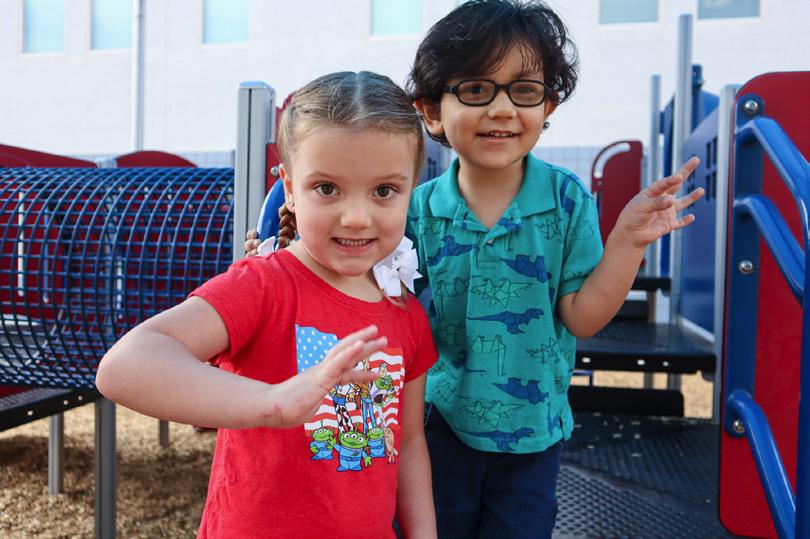














Q & A With Reading Specialist & Neurodivergence Expert Tina Bauschatz, MA
What are some common learning disabilities in children? Some common learning disabilities we see in children are ADHD, dyslexia, dysgraphia, dyscalculia, and autism. Of course, autism isn’t thought of as a learning disability per se, but the comorbidities and behaviors can make it a bit more challenging to learn as effectively and successfully without the proper tutoring interventions.
What are some indicators that my child may have a learning disability?
If you’re concerned your child may have a learning disability, there are a few signs that serve as indicators. These include difficulties with memory, paying attention or staying focused, following or understanding directions, or requiring instruction to be repeated multiple times.
What are the next steps I can take when I suspect my child has a learning disability? Learning intervention is critical. Seek out intensive tutoring by experts. Oneon-one or small group tutoring should be systematic, sequential, multi-sensory, and Orton-Gillingham based. It’s also important
to learn and share your child’s particular needs to help with his/her learning. These needs may include more breaks, repetition, visual aids, and manipulatives.
My child struggles with ADHD and it’s difficult to get them to focus while completing assignments. What can I do? You can help your child stay focused by letting him/her get their energy out beforehand, and giving frequent breaks during work. Keep the breaks short – maybe play two games of tic-tac-toe or let your child do a few jumping jacks – then get back to work. Let your child set a timer so they can work on staying focused for that short period of time. You can also use a reward strategy. For example, if they complete a task (such as a homework assignment), then they get a big reward such as 5 minutes of screen time. After that, they have to get back to work! Build up their stamina by gradually increasing the amount of time they work between breaks.
How can I partner with my child’s teacher to help? Request a meeting with your child’s teacher(s) to discuss appropriate
accommodations and realistic goals. Ask the teacher what you can do to support your child’s learning at home, advocate for feedback and updates about your child’s progress, and discuss any problems.
How can a tutor help my child with his or her particular learning struggles? Not every tutor is qualified to provide effective instruction to a child with learning differences. Tutors who have training in Orton-Gillingham methodology know exceptional education needs, and have experience teaching children who have learning differences. They are going to be more effective at teaching those types of learners, using specific multisensory techniques, breaking down concepts, and using repetition in a way that works best for neurodivergent learners.
Tina Bauschatz, MA, is the Founder & Director of Marmalade Skies Tutoring, which serves families in southern Arizona. “Miss Tina” is a Reading Specialist, Neurodivergence Expert, and a leader in her field. Visit marmaladeskies.com or call their main tutoring center at 520-849-8432.
By Kate Reed

NEARLY EVERYONE can agree that it’s hard to learn something new when it’s boring. Reading is no exception—particularly for kids! Mastering sight words is one of the most important factors that impacts reading fluency in children, and sight words like ‘the’, ‘to’, and ‘you’ make up around 75% of beginner books.
Fun fact: Kids who read for at least 20 minutes a day are exposed to approximately 2 million words each year!
Invented by a local mom and reading interventionist, Kristen Bateman, Growing Words was inspired by Kristen’s students who were struggling with reading. She began implementing games and activities into her lessons, and like magic, the kids began to not only succeed at reading, but enjoy it!
Growing Words has 6 kits, each with 20 sight words - for a total of 120 words. The kits are designed for newer readers ages 4 to 7, or intervention students ages 7 to 9.
We used the first kit: Sight Words 1-20, for our 5-year-old (going into kindergarten) and he picked it up quickly. Each kit has 12 different activities such as matching, reading and writing words, sticky frog, catch a frog, boom, sentences, board game, bingo, and several other variations. It easily keeps your child entertained, and they won’t even realize the important skills their brains are grasping while doing the activities.
Sometimes we’d play in the morning during breakfast or before bed. Other times we’d pull it out when the baby napped, it was raining outside, or we just needed a quiet activity. It also neatly packs away so you can travel with the kit! We always did it as a fun activity and never forced it. In fact, he’d ask us to play with it!
Now, when we’re reading at bedtime, he is able to recognize words and is starting to read sentences. Each skill serves as a building block for the next. Once he was able to recognize some of the sight words, we were able to work on phonics. Now, when we’re out and about, I can see the pride in my son’s eyes when he can recognize words on his own.
Another great feature of Growing Words is that it can be reimbursed for using ESA funds or you can use Class Wallet - a great option if you’re homeschooling or your family is utilizing this type of funding for the school year.
Whether you’re trying to get a head start on reading or your child needs a little skill-improving, Growing Words is the best way to introduce a love for reading—by mastering sight words at home.
Find your kit at growingwordsllc.com





By Trent Reed • Photos by Kate Reed
TWENTY EIGHT OR more hours a week. That’s how many hours I spent on social media each week. Nothing important. Just meaningless content about politics, other families’ extravagant parties, vacations, and homes, products we needed to buy to be happier, and all the things I was doing wrong as a father. Twenty eight hours of time that could be spent with my family…just gone.
I would wake up and scroll. Go to the bathroom and scroll. Get a cup of coffee and scroll. Change a diaper and scroll. You get the idea. I was addicted. As if this social media content I absorbed would provide some fulfillment in my life. My kids would ask if I could read them books, there were dishes to be washed, dogs to be walked, laundry to be folded, and dozens of other tasks that could be completed. But I was too busy.
I’d love to say that I came to this decision on my own, but it took an argument with my wife one night when she admitted I wasn’t pulling my weight (as she mopped the floors at the end of the day, and I scrolled social
media). I was so sure I was being productive and helpful as a stay-at-home-dad, but it was a solemn moment when I realized my wife was still doing 80% of the household chores and was still the default parent. I told her to make me a list. She frustratingly chuckled because it was ONE more thing I put on her plate. “You have eyes, right”? She asked.
She asked me what I did in the morning if I was the first up with the kids…“letting” her sleep in. I didn’t have to think long…. I would put on a movie for the little ones and laid on the couch consuming as much content as I could. She explained that when she was the first awake, she made coffee, breakfast for the kids, cleaned the kitchen, washed and folded laundry, swept and mopped, cleaned the bathroom, made a list of grocery items needed, or played with the kids. She didn’t have TIME to be on her phone. At first, I was angry at the accusations. But I knew she was right.
So, I deleted my social media apps. All of them. And my life changed almost immediately.

I slept better, woke earlier, and got up in the morning ready to tackle the day. I started taking more walks and working out, I meal prepped, took over the grocery shopping, school registration, and was just more present with my kids. I even started making the bed before my wife could get to it. For the first time, I feel fulfilled.
I still instinctively open my phone to jump on social media but that’s becoming more infrequent as I fill my time with more valuable things.
My boys’ childhoods were flashing by… right in front of me. I almost missed it. What could you do with 28 more hours in your week?
By Sean McClintock
THE RELATIONSHIP BETWEEN a father and daughter is a unique and special bond that plays a fundamental and significant role in every young girl’s life. Daughters who have healthy bonded relationships with their dads are more likely to have a positive self-image, empowering self-talk, academic success, and healthier relationships with men as adult women.
Here are 5 ways dads can strengthen the bond with their daughters:
1. Spend one-on-one time together: Set aside regular, undivided attention time with your daughter, and create rituals of togetherness, whether it's a weekly "daddy-daughter date" or a monthly weekend adventure. This dedicated time allows you to connect without distractions and create memories that will last both your lifetimes. They will not remember the things you bought them as much as the experiences you shared.
2. Engage in shared activities that are unique to you both: Share your favorite hobbies, sport, or other activities and make time to do them together. Teach them strategy games you enjoy like chess, mancala, or card games that allow you to generate discussions around thinking ahead and working through wins and losses with dignity. Go for hikes, cook meals together, or visit bookstores, amusement parks, or museums. Discover and share what you both enjoy together.
3. Have open meaningful conversations: Practice using openended questions, give space for your daughter to think and express her thoughts, while making an effort to have honest, thoughtful discussions with her. Ask about her interests, challenges, and dreams, and share your own lessons from lived experience and personal perspective. These simple yet profound conversations build trust and understanding, while giving words to your morals, beliefs, and values that matter to you as a father. She will inherit your resilience and fortitude.
4. Provide encouragement and support: Actively listen to your daughter, validate her feelings, and offer reassurance and guidance without judgment. Focus on effort and action, instead of missed opportunities and disappointment. Celebrate her accomplishments and let her know you believe in her always. Soothe her suffering of loss with compassion while you help her understand that failures are part of the pathway to success. Reinforce that our most powerful life lessons come from challenging and rewarding experiences.
5. Be a positive role model: Demonstrate through actions the qualities you hope she will emulate, such as integrity, kindness, and emotional maturity. The way you interact with your daughter and others will profoundly shape her views on relationships. The key is to make your daughter feel heard, valued, and secure in your love and support. Consistent, stable, thoughtful effort can strengthen the father-daughter bond and provide a foundation for a lifelong, meaningful relationship.

By Ben Mills & Oliver Mills
HEY DAD! Welcome to the club! You are now part of The Fatherhood – or, as I see it, an elite group of superheroes.
The life of a parent has both rewards and challenges. And in my opinion, it is important to have dad friends, or Super Friends, along for this unique adventure, especially in the early years of your kid’s life.
Super Friends differ from your lifelong friends in that they have mostly entered your life since becoming a father. The unique challenges of parenthood create a bond that other parents recognize in one another.
For some of us, making friends comes easy. However, when it comes to making a dad friend, there may be some hesitation. You may now find yourself searching at daycare drop-off or using online social apps (like Phoenix Dads Group on Meetup) for some Super Friends.
While writing this article, my six-yearold son, Oliver, informed me that he had lots of experience making new friends in kindergarten this past year. We hope these three simple steps will help you with making your own Super Friends!
Step 1: Seek the opportunity
“Ask to sit next to your new friend and play with them at recess so you can learn more about them.” – Oliver
Start by identifying a venue that you enjoy, as it will help increase the likelihood of meeting a new dad friend with common interests. I tried strolling my kids around the mall and taking them to local playgrounds. Finally, I attended an at-home dad conference in which I got connected with City Dads (Phoenix Dads Group) via the Meetup app.
Step 2: Create the opportunity
“Say hello, be nice, don't yell, take turns, share toys and food, and say, ‘Goodbye!’ and ‘See you later!’” – Oliver
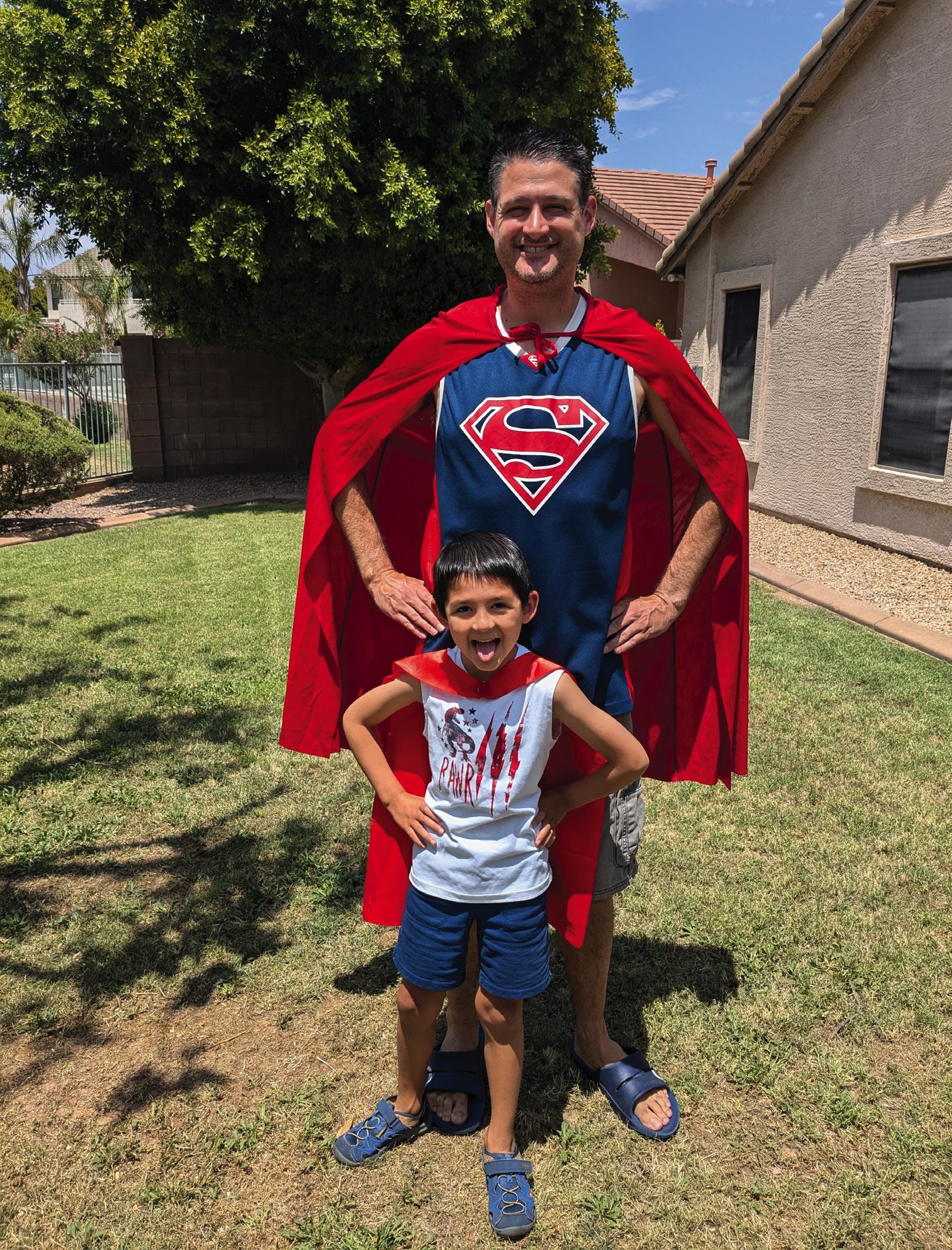
Breaking the ice can be as simple as sharing a dad joke, commenting on the challenges of fatherhood, or even commiserating over the lack of adult-friendly food at most kid play places. The majority of my Super Friends have at least one kid that is close in age to one of my two kids. If your new potential dad friend does not have a child close in age to your own, you can still offer a snack pack or compliment to break the ice.
Step 3: Seize the opportunity
“Once you get to know them more, ask them over for a playdate. Pick some toys that you are okay with sharing or go to a fun play place. Also, make sure their parents agree, too!” – Oliver
Keep venue selection simple. I started out by picking a park near my new dad friend’s
house. The next time, he came over to my house. As we got to know each other better, we went out to baseball games, concerts, and Top Golf without the kids.
Good luck assembling your Super Team of Super Dad Friends. Until next time... Up, up, and away!
Ben Mills is a full-time at-home dad who has been married to his partner for 10 years. Together they have two kids, ages 6 and 3. He is a Tucson native who now resides in Avondale. Ben currently serves as the Co-Organizer of Phoenix Dads Group: a dynamic, diverse and inclusive community of fathers dedicated to being active in their children’s lives and, by example, redefining what it means to be a dad in the 21st century.
By Monique Seleen
TODAY’S MODERN-DAY dad wears many hats—often juggling home life, a career, family, and more. Gone are the days of traditional gender roles where the female does all the homemaking while the man works outside the home. Many dads today are showing up and splitting the load equally. Here are three outstanding Valley dads who have pursued careers locally, are raising children, and making a lasting impression within the community.
Do you know a local rad dad? Send an email to monique@ rakmagazine.com to recognize an exceptional dad in your life!

JOEY MAGGIORE originally learned and developed his talent in the kitchen alongside his father, culinary legend, Tomaso Maggiore. Tomaso’s Italian Restaurant was established in 1977 on The Camelback Corridor, and it was here in the family restaurant where Joey’s culinary career was ignited, eventually leading him to the growth of his family business. Joey is often found traveling and learning to bring amazing food and culture to his brands. Joey’s family is the heart of all he does, with wife Cristina and three children Giuliana, Tomaso and Melina being his pride and joy.
Joey is known as “the concept guy” in the foodie world, opening over 40 restaurants, making several TV appearances, and gaining national acclaim. His concepts have been featured and awarded in many publications, including Thrillist, USA Today and Forbes.
Joey’s TV features include Food Network, Travel Channel, and his own show on Food Network: Family Style. Joey and his Maggiore Group founded brands keep the excitement going with several brands going national this year, including Hash Kitchen, The Sicilian Butcher/Baker, and The Mexicano.
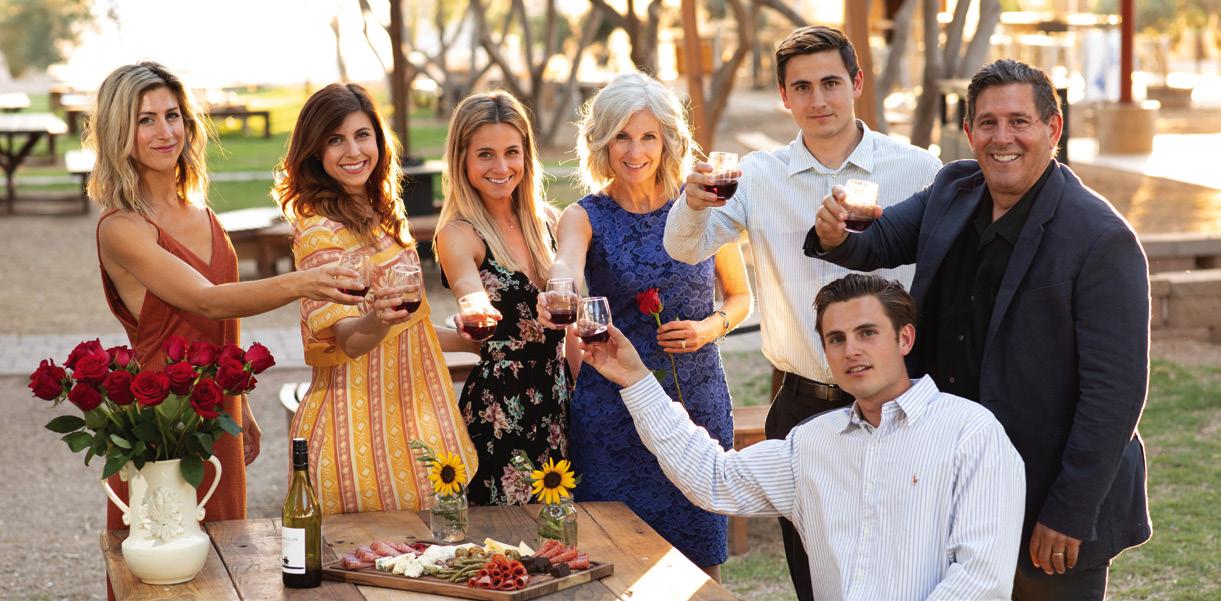
PERRY REA is the owner and olive oil sommelier for the Queen Creek Olive Mill. This father of five oversees the growing, milling, and tasting of The Mill’s olives for extra virgin olive oil from blossom to bottle. As an olive oil sommelier, Perry has been trained to evaluate Extra Virgin Olive Oil from their partners-in-passion around the world to deliver the highest quality and the freshest products while still practicing sustainable farming. Together with his wife, Brenda, they started the Queen Creek Olive Mill with the idea of providing the Arizona community with fresh, local extra virgin olive oil.

KURT RISKE is the brand mastermind behind Level Up Projects, co-owner of Los Sombreros and father of two. After he earned his degree in Psychology from Panhandle State University where he played college baseball, Riske set off to play professionally in Holland. When he had to return to the States due to an injury, Riske decided to jump back into the world of restaurants that he knew and loved. Prior to graduating, Riske worked at the restaurant he now owns – Los Sombreros! Before owning his own restaurants, he worked as the Regional Director of Operations for Black Bear Diner and Smashburger, helping each with significant growth plans in his home state of Arizona. Riske is passionate about helping people, his role in his family, and works closely with many local nonprofits to improve his community.

By Monique Seleen
CHILDHOOD BIRTHDAYS are unlike any others. I have fond memories of waking up on my birthday morning anticipating all the fun that was in store.
With three kids who had birthdays all in the same month, my parents really did their best to try and make each of us have individual celebrations, even if to them it felt like it was just one birthday after the next.
If you’re looking for ways to make birthdays extra special in your family, here are some fun birthday traditions to try:
Balloons/decorate the house. My mom used to decorate the kitchen with streamers and banners, and tie a balloon to our chair at the table. It was simple, yet made it feel special. I’ve seen other people who decorate their kids’ playroom, do a balloon avalanche that the kids can bust through when they open their door, and more. Make it as simple or over-thetop as you’d like!
Donuts for breakfast. There’s no limit on how many times you can sing happy birthday in one day. You can start the birthday morning with a donut, a candle, and a wish!
Family fun outing. My parents used to let the birthday kid choose something fun that the whole family could go do together to celebrate. This ranged from bowling, a trip to the movie theater, ice skating, mini golf, etc.
Dinner of their choosing. Whether it’s a home-cooked meal, or dining out at a favorite restaurant, let the birthday person pick what’s for dinner!
Birthday interview. A great way to recap the year, ask the birthday boy or girl a series of questions about themselves. You can make a video or simply write down their answers as a memory.
Birthday dessert of choice. Sometimes cake gets all the credit on birthdays. Mix it up and ask the birthday person what dessert they’d prefer. I used to always request a giant cookie or brownies instead!
Gifting/planning a future one-on-one parent date. One of the most valued gifts you can give is the gift of time. Try planning a future one-on-one parent date for the birthday boy or girl. They can “cash it in” to be used at a later date for some extra special alone time with a parent.
IF YOU’RE IN the midst of planning a birthday party for your child, here are some clever birthday party theme ideas for ages one to five!
AGE ONE:
• Winter One-derland (winter theme)
• ONE-ce Upon a Time (fairytale theme)
• Hole in One (golf theme)
• Home One (baseball theme)
AGE TWO
• Two Infinity and Beyond (Toy Story theme)
• Monkey See Monkey Two (monkey theme)
• Taco TWOsday (fiesta theme)
• Two the Moon (space theme)
AGE THREE:
• Young, Wild, and Three (jungle/wild theme)
• Three Rex (dinosaur theme)
• Three-I-E-I-O (animals/farm theme)
• It’s Sweet to Bee Three (bee/honey theme)
AGE FOUR:
• We All Scream Four Ice Cream (ice cream party)
• Fantastic Four (superhero theme)
• Four-ocious (dinosaur theme)
• Four-Wheeling (cars/tractor theme)
• May the Fourth Be with You (Star Wars theme)
AGE FIVE:
• Five Guys (burgers & fries diner theme)
• Five Little Monkeys (monkey theme)
• Dive Into Five (pool party)
• Take Five (sports theme)






By Monique Seleen
WANTING TO DO something a little extra special for your child’s next birthday party? Maybe it’s a milestone birthday—like turning double digits or entering the teen years. Or perhaps your child has requested to do something unique that none of their friends have done before.
Here are three local ideas that are not only going to be Instagram-worthy, but will surely be a crowd pleaser too!

Fire up for blazing hot birthday fun! When you host a birthday with The Fantastic Fire Department®, your child and the birthday guests will get the chance to interact with a fire truck up close while seeing the lights flashing and hearing the sirens blaring. The big red fire truck arrives with a team of friendly firefighters to deliver a high energy, hands-on experience with interactive play and learning opportunities, real firefighter gear the kids can wear, custom themed games, prizes, contests, tons of authentic fire equipment. With some add-on packages, guests can even go for a ride in the big truck!
Birthday packages start at $335. Find out more at fantasticfiredept.com/phoenix
Let your child feel like a movie star when they celebrate their birthday at Roadhouse Cinemas in Scottsdale. With three different party options, your event can include a private movie screening room, kids’ popcorn packs for guests (complete with popcorn, a drink, and a snack), goodie bags, a photo booth, choice of meal, a special gift for the birthday boy or girl, and more!
Birthday packages start at $525. Find out more at roadhousecinemas.com/movietheater/scottsdale/events
Plan a party that’s fit for a princess when you book your event at The Pink Tea Pot in Gilbert. Choose from the Princess Tea Party package (recommended for ages 3 and up), where the birthday kid and guests will get to enjoy a live princess of your choice, finger sandwiches, juice served in teapots, a mini makeover for the birthday princess, games, an interactive story time led by a princess, and a princess themed cake.

Or book the Fancy Tea Party packages (for ages 8 and up) which includes at least two party helpers, personalized digital invitations, finger sandwiches, tea or juice in teapots, a mini makeovers for all guests, dress up with hats, gloves, and bracelets, and more!
Birthday packages start at $400. Find out more at thepinkteapotaz.com



By Monique Seleen
MY BROTHER and I have birthdays that are just one day apart—his on March 3rd, mine on March 4th, and our oldest brother just a few weeks later on March 21st
Fast forward 31 years later, and my son decided to make his grand entrance on March 2nd. Needless to say, March is just one giant birthday month in our family.
While this can be fun at times, it also means chaos of constant cake, presents, and decorations – and usually means we’re all sick of birthdays by the time March is over.
Maybe your family has a similar birthday conundrum – all in the same month, back to back days, twins, or even just a few weeks apart.
A solution for the madness? Host a joint birthday party celebration. Here are some unique ways to combine birthdays while still making each person feel special:
• Have a dessert buffet. Does one person love cake, but the other loves brownies? Put together a dessert buffet so each birthday person gets their favorite sweet treat, and guests can also choose which one (or both) to have. Think cake pops and brownie bites, or cupcakes and cookies – there are endless combinations to choose from.
• Find similar, but separate themes. If you have two different genders, they might have totally different interests. Try seeing if you can find some commonality between their themes. Some examples include:
• Dinosaurs and Unicorns
• Sister and Mister
• Mermaids and Pirates
• Ice Cream: Two Scoops are Better than One
• Trucks & Tiaras
• Acknowledge their actual birthday. My mom was always so good at making each of us feel special on our actual birthday. We’d get to pick the dinner that night and a special outing the whole family could do together to celebrate, such as going to the movies, bowling, ice skating, etc. Even though I’m sure it was a lot of work, it made our individual day still feel acknowledged.
• Pick a place to host that’s suitable for both. If you’ve got a larger age gap between kids, finding a place to host the birthday party can get tricky. Here are a few generic options you could try:
• Pool party
• Pizza party (Peter Piper Pizza, Chuck E. Cheese )
• At home (lots of party rental options you can bring to your house)
• Entertainment venue with multiple options (Main Event, Jake’s Unlimited, Fat Cats, etc.)
• Nearby park
• Plan a joint slumber party. Keep things simple and let each kid invite one friend over for a sleepover, complete with popcorn, pizza, and their favorite movie. If they can’t agree on a movie, perhaps find two different viewing areas – maybe one kid gets to hang out in the living room with their friend, while the other gets to watch it in the backyard. For a more elaborate experience, try booking with a sleepover rental company such as Sleepy Teepee, The Slumber Shack, or Night Owl Sleepovers for an unforgettable themed setup.
No matter how you choose to celebrate, it’ll surely be a memorable experience for all.



By Monique Seleen
CALL ME CRAZY, but when my husband and I adopted our first dog together, we threw her a birthday party complete with cake, streamers, guests, appetizers, games, and more. Was it a little over the top? Yes. Was it filled will obnoxious dog puns? Also yes.
But who says dogs can’t have elaborate birthday parties, too? While we did this in our pre-kid era, I think it would be even more fun to get your kids involved in the planning and decorating process as well.
Here are some ideas to on how to throw a paw-some birthday party for your family pet:
Throw a birthday party at a local pet boutique. Several local pet organizations have party packages specifically designed for your pet. Check out these two party packages for pups:
• Fur Babies Resort in Paradise Valley offers a party package that includes 10 dogs, 2 hours of playtime, bubble play, pup photos and doggie “goodie” bags provided to each pup.
• Dogs of Tucson offers a package that includes a reserved table in the indoor lounge for 2 hours, birthday decorations, a “pawty” hat, customized birthday card, customized birthday banner with a picture of your pup, their name, and age, and a custom dog cake, and goodie bags.
Grab your pet’s favorite treats from a local dog bakery. Find a local dog bakery and order your furry friend a special treat to celebrate. Here are a few bakeries to check out:
• Happy Tails Barkery
743 S Lindsay Rd #105, Gilbert • happytailsbarkery.co
Dog cakes, cupcakes treats and more made with high quality, allnatural, human grade ingredients.
• Three Dog Bakery
1085 W Queen Creek Rd #5, Chandler • threedogstores.com
Specialty cakes, treats, cookies, pupcakes and more.


• Peyton & Daisy Rey’s Bakery
505 S Chandler Village Dr Ste 36, Chandler • peytonanddaisybakery.com
Pet treat bakery specializing in dog biscuits, cakes for dogs, cat treats, horse treats and more!
• Dogs N Donuts
7743 E Broadway Blvd, Tucson • dogsndonutstucson.com
Offering custom dog cakes, cookies, donuts, and more.
• Cones for Bones
6121 E Broadway Blvd Ste 138, Tucson • conesforbones.com
Tucson’s first doggy ice cream bar!
Bake a cake for your pup at home. My sister-in-law is notorious for baking at home with her pup. There are all kinds of at-home baking mixes you can buy, or simply look up some pet-friendly recipes online. Most only use a few simple ingredients such as peanut butter, yogurt, and applesauce.
Plan a “punny” birthday celebration. When we threw a birthday party for our dog, I used all the puns to create the ultimate dog celebration. We even had little “doggie bags” for guests to take on their way out. Here are a few of the food puns I used:
• “Pup” corn – bowls of popcorn
• “Pup”eroni pizza – slices of pepperoni pizza
• “Puppy chow” – a sweet chex mix
• “Pup” cakes – cupcakes
• “Paw”sta salad – a cold pasta salad
• Fruit Kibble – a fruit salad
Buy some special birthday attire for your pet to wear. The birthday celebration isn’t complete without some festive attire! There are lots of fun options both online or at your local pet store for your furry friend to wear including shirts, dresses, bandanas, party hats, and more!

By Monique Seleen • Photos by Melissa Fritzsche Photography
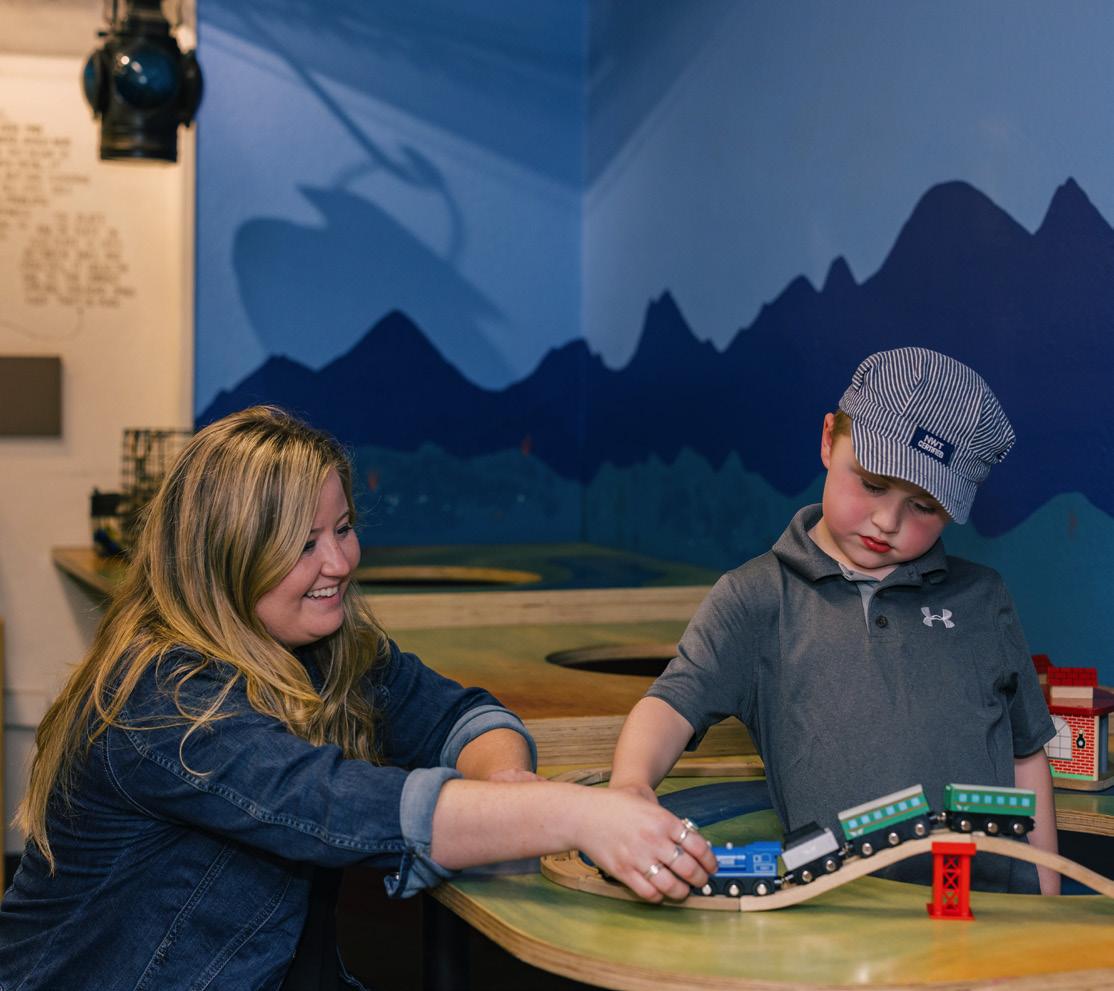
SEVEN-YEAR-OLD Hudson Sanford now has a chance to live out a normal childhood thanks to an FDA-approved gene therapy treatment he received for Duchenne, a rare type of muscular dystrophy.
But, it was a treatment that almost didn’t happen, since it was only approved for children ages four and five years old, and Hudson was just weeks away from turning six.
The journey first began when Hudson’s preschool teacher noticed that he wasn’t meeting some milestones like his peers.
“He was using his hands to get off the floor, running a little slower, and wasn’t jumping,” said Melanie Sanford, Hudson’s mother.
After appointments with a neurologist, genetic testing results came back indicating Duchenne—a rare, genetic disease ultimately leading to progressive muscle damage and weakness.
Duchenne typically affects males, and muscle weakness becomes increasingly noticeable between two and five years old. Most children living with Duchenne use a wheelchair beginning around age 13.
“It was really devastating for us,” said Melanie. “We did not have a great first experience and were told there was not much we could do.”
Refusing to accept the discouraging prognosis for their only child, Melanie kept digging for options, eventually stumbling upon gene therapy, which was just coming through clinical trials.
As a newly approved treatment, gene therapy for Duchenne is currently only available to children ages four and five years old.
“It was so amazing to read about the gene therapy for Duchenne since there’s no other treatment besides steroids,” said Melanie. “But I still wasn’t very hopeful because Hudson was about to turn six.”
Acting quickly, the Sanfords were put in contact with Dr. Diana Castro and the CureDuchenne Clinic in Texas, and just a few days later, had their first appointment.
Although the Sanfords had some hesitations, they ultimately decided to try and go forth with seeking treatment.
“We knew the alternative and what the future would have looked like,” said Melanie. “This would give him the best future possible so we

knew it was the right decision.”
After a series of preliminary tests and an appeal after their insurance initially denied it, on August 18th, 2023, Hudson was able to receive the gene therapy infusion, just three days shy of his sixth birthday.
The one-time treatment given through an IV infusion treats the underlying cause of Duchenne by delivering a shortened dystrophin gene to the skeletal muscle.
Melanie said the overall process from start to finish took just a few hours, but the results are having long-lasting impacts.
“He is not even the same child,” said Melanie. “He runs around, jumps, runs up the stairs, he’s even on a bowling league. Around his age, kids usually start to decline, but he’s improved and gained strength, and we’re so happy with everything he’s able to do.”
As Hudson now gets the chance to carry out all the normal day-today activities of a seven year old, the Sanfords are feeling grateful for their experience and hope other Duchenne children and their families remain optimistic.
“I want others to know that if they do get this diagnosis it can be devastating, but there are so many people who want to help,” said Melanie. “The future is definitely bright and I feel very thankful for the people who have helped us.”
For more information on Duchenne visit duchenne.com

PREPARING A CHILD with special needs for a dentist appointment requires thoughtful planning and sensitivity. Here are some practical tips to help you navigate dental visits with your child:
Pediatric dentists often receive additional education in areas such as behavioral management and communication techniques for treating children with special needs. Seek recommendations from your child’s doctor, local parent support groups, or organizations related to your child’s specific diagnosis. When you call to make an appointment, inform the office staff about your child’s extra support needs.
Use books, videos, and social stories to introduce the concept of visiting the dentist. These resources can help your child understand what to expect and reduce anxiety. Pretend play can also be helpful. Role-play a dental visit at home using the dental toys, allowing your child to take turns being the dentist and patient.
Arrange a pre-appointment visit to the dentist’s office. Let your child explore the waiting area, meet the staff, and see the dental chair and
By Ascend Pediatric Dentistry
equipment. Familiarity can ease anxiety. If possible, introduce your child to the dentist during this visit.
Plan an activity or reward that your child can look forward to after the appointment. It could be a favorite toy, a special treat, or a fun outing. Count down to the appointment day and make it seem exciting. Use visual calendars or simple countdown charts.
Talk openly with your child about the upcoming visit. Use age-appropriate language to explain what will happen during the appointment.
Address any specific fears or challenges your child might have. For instance, if your child is afraid of loud noises, discuss how the dental tools might sound and reassure them.
Some children with special needs are sensitive to sensory stimuli. Discuss any sensory accommodations your child might need, such as dimmed lights, noise-canceling headphones, or a quiet room with the dentist. Consider bringing noise-canceling headphones, sunglasses, or a weighted blanket to provide comfort during the appointment.
Visual schedules or social stories can help
your child understand the sequence of events during the visit. Create a simple visual guide that outlines each step, from entering the clinic to sitting in the dental chair.
Schedule the appointment at a time when your child is typically more relaxed and cooperative. Avoid times when they might be hungry or tired.
Allow your child to bring a comfort item from home—a favorite stuffed animal, a cozy blanket, or a familiar toy.
Having something familiar can provide a sense of security.
Be patient and flexible during the appointment. Understand that it might take longer than usual, and the dental team may need to adapt their approach to accommodate your child’s needs.
At Ascend Pediatric Dentistry, we understand the unique challenges and joys of caring for children with special needs. Dr. Mark brings a personal touch to our practice, inspired by his own family members with special needs. This deep understanding fuels his dedication to providing exceptional, individualized dental care. Call 480-3762226 or visit ascendpediatricdentistry.com to book your appointment, and let us make dental care a joyful and inclusive experience!


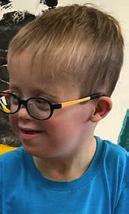








By Susan Kricun • Photos courtesy of Ryan House
COUNTLESS CHILDREN face life-limiting conditions or endure life-changing accidents every day, profoundly affecting their lives. The endless cycle of medical appointments, surgeries, and at-home care can become daunting and exhausting for both the child and their family. This is where pediatric respite care steps in, providing a vital source of relief and support.
Pediatric respite care provides short-term, temporary relief for primary caregivers of children with serious health conditions. According to the ARCH National Respite Network and Resource Center, respite care is the most frequently requested service among the nation’s 53 million family caregivers. This service is designed to alleviate the physical and emotional burdens that accompany continuous caregiving.
Respite care offers numerous benefits for caregivers and their

families. These benefits include:
• Significantly reducing caregiver stress and depression
• Alleviating sleep deprivation
• Lessening the sense of burden
• Improving overall family health and well-being
• Reducing the risk of caregiver burnout
• Enhancing quality of life, including improved marital relationships and better parental employment outcomes
For Arizona residents, Ryan House, a Phoenix-based nonprofit, provides an invaluable service for families caring for children with medically complex needs by providing a loving community where children can truly be themselves and live their lives to the fullest in a safe, homelike environment.
Its mission is to enrich the quality of life and create cherished

memories for children and their families, providing a much-needed break from 24/7 caregiving, as they navigate life-limiting or end-of-life journeys. As the only facility of its kind in Arizona, and one of only three in the United States, Ryan House stands out for its commitment to these families.
Ryan House, recognized by the ARCH National Respite Network for its innovative and exemplary respite services, offers families up to 28 days of respite care per year, with up to seven consecutive days of care per visit, all at no cost. This crucial service is entirely funded by donations, as there is currently no reimbursement available for this type of care.
For many families, respite care at Ryan House is their only connection to these essential services and support. Respite stays are a critical lifeline for them, offering a safe, nurturing environment where children receive personalized, expert care from our prestigious care partners and highly trained clinical staff.
Ryan House’s Executive Director, Tracy Leonard-Warner, highlights the importance of community support in maintaining these services. “Thanks to the incredible support of our community, we are fortunate to continue to offer respite services to the children and families we serve. Families can rest knowing that our clinical staff excels at providing care and services while they take a much-needed break from 24/7 caregiving.”
Ryan House provides a wealth of information and resources at ryanhouse.org. Among many things, visitors can take a virtual tour and get a glimpse of the facility and the comprehensive services offered.
Pediatric respite care is an essential service that offers relief and hope to families dealing with the intense demands of caring for a child with a life-limiting condition. Through the dedicated efforts of organizations like Ryan House, caregivers can find the support they need to maintain their well-being and continue providing the best possible care for their children.
Ryan House enriches the quality of life and creates cherished memories for children and their families, providing a much-needed break from 24/7 caregiving, as they navigate life-limiting or end-of-life journeys. For more information visit ryanhouse. org Follow us on Instagram and join us on Facebook





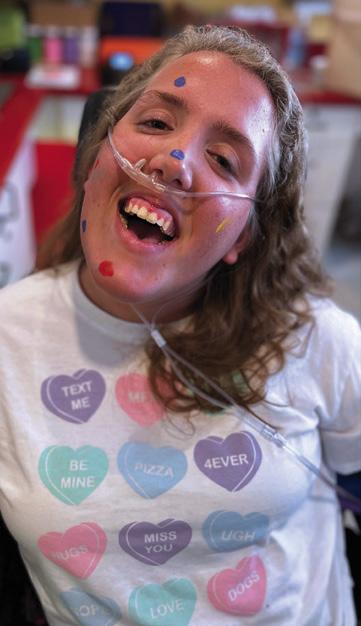
Ryan House enriches the quality of life and creates cherished memories for children and their families, providing a much-needed break from 24/7 caregiving, as they navigate life-limiting or end-of-life journeys.
Our services are provided at no cost to families. We are 100 percent funded by donations.
Arizona’s only pediatric respite and palliative care facility.
By RAK Staff
Arrowhead Meadows Park: 1475 W Erie St, Chandler
This playground displays bright, primary colors and features:
• GameTime’s innovative wide ramps, allowing two wheelchairs to pass each other
• Accessible decks that allow children in mobility devices to reach the highest play components
• A RockScape climber
• Many ground level activities including GameTime’s Jams musical play, for those who are more comfortable using lower play components
• ADA accessible stock car and a whirlwind seat
Dobson Ranch Park:
2359 S Dobson Rd, Mesa Dobson Ranch playground is 10,000 square feet with features such as:
• A multi-layer play experience with upper and lower play structures connected through ramps
• Toddler expression swings that allow parents to swing with younger children
• Sandbox table and musical instruments to encourage sensory play
• A 50-foot double zip line with supported seat and disc for side-by-side play
• Triumph Climber with transfer station for side-by-side climbing
• Cozy Cocoon and Saddle Spinner for children who need a quiet space
• Mixed surfacing with rubber and wood fiber
• Updated restrooms to meet ADA requirements
• Inclusive play structures and shaded playground
Encanto Park: 2605 N 15th Ave, Phoenix
The new ADA accessible playground features:
• A Sway-fun glider – a wheelchair accessible glider that meets all safety standards and allows children with mobility limitations to experience the joy of swinging alongside their friends and family

• A communications board sign – an effective way for non-verbal, speech challenged and early-learning individuals to communicate with friends and caregivers. This interactive tool promotes social interaction and inclusivity among all children
• A variety of swings with belts, full bucket seats for infants, and molded bucket seats for children with limited upper body strength
• Sensory play options
Frontier Park:
20039 S 220 St, Queen Creek
This new park in Queen Creek is ADA accessible and includes:
• Several ramps to reach the highest parts of the playground
• An inclusive-friendly playground structure
Jordan’s Corner:
15681 N Hayden Rd Unit 116, Scottsdale
Jordan’s Corner is an indoor play place for children under the age of 6. Over 2,800 square feet of purposeful play including:
• Sensory play
• Swings
• Montessori climbers
• Soft play
• Interactive wall
• Art and cars table
• Daily staff led activities
• Meet & greet princesses
• Story time
• Parent rest spots with complimentary phone chargers, access to coffee and clean meals, and an open layout, so each child can be seen from every corner of the room
Lily’s Pad: 3320 S Priest Dr, Suite 4, Tempe
A hyperclean, indoor playground designed to provide immunocompromised children and their siblings with a clean environment where they can enjoy typical childhood activities. Features include:
• Two slides and a climbing wall
• Pop-A-Shot basketball game
• Air hockey and foosball table
• Balls, hula hoops, and scooters
• Ride-around cars and bikes including a remote controlled fire truck and police car
• A toddler area with books, building blocks and small toys
• A small bounce house and an arts and crafts area
Little Dreamer’s Playroom:
13615 N 35th Ave, Suite 5, Phoenix
This indoor play space offers a Sensory Room especially designed for kids who may become overstimulated. The sensory room offers:
• A separate quiet area behind a closed curtain
• Cool, dim lighting
• Calming music
• Soft play
• A ball pit
• Lego wall
• Stuffed animals
• A rocking horse
Milagro Playground at Jacobs Park: 3300 N Fairview Ave, Tucson Milagro Playground includes:
• Wheelchair accessible picnic tables
• 720-foot Challenge Circuit that surrounds the park
• Triple-Shootout basketball court with baskets of varying heights
• Seat walls
• Sand and water play area
• Swings for tots
• Climbing structure with slide
• Surfaces made of rubberized cement
• Play area for 5-12 year old children with ramped play modules and discovery learning stations
Reid Park Playground:
900 S Randolph Way, Tucson Disability-friendly features include:
• Platforms with ramps
• Wider paths
• A cruiser that can be used by a wheelchairbound child as they play with others.
• Music components that can be easily accessed along playground sidewalks
• Handicap swings
Stewart Vincent Wolfe Creative Playground: 282 N 12th Ave, Yuma
Also know as (Castle Park), this playground is a 17,000-square-foot kingdom for kids— over 3 acres of playground! A unique ADA playground that has been recognized as one of the largest creative playgrounds, as well as one of the top 20 playgrounds in the country, for being “impressive, accessible and inclusive.” Features include:
• Slides (including tunnel slides from within the castle towers)
• A climbing wall
• Nooks for creative exploration
• Pebble Flex ground cover that is soft and squishy, ensuring safe landings
• A zipline
• A giant TriNet climbing structure
• A comfort swing
Telephone Pioneers of America Park: 946 W Morningside Drive, Phoenix
Telephone Pioneers of America Park has:
• Two beep baseball fields for those who are visually impaired
• Therapeutic heated pool
• Wheelchair-accessible playground
• 18-station exercise course
• Wheelchair accessible sports courts
By Monique Seleen

FOUNDED IN LATE 2021 by Phoenix teen, Nandini Patel, The Calming Couch distributes Calming Kits to kids ages 7 to 11, in an effort to create awareness of common mental health issues, and to help kids find a way to cope with things like anxiety and depression.
After struggling with her own mental health, Patel started the non-profit organization at the age of 15 in an effort to help others.
“I understood that the only way I was able to develop a positive outlook was due to the people that surrounded me as well as my ability to access mental health tools,” said Patel. “This motivated me to create The Calming Couch in hopes that it would provide both a safe and positive community for those who need it.”
The organization works primarily through its Calming Kits which are filled with mandala designs, crayons, stress rings, journals, pencils, stickers, habit trackers, breathing techniques, and affirmation cards.
“These items aim to relieve stress and shift one’s anxiety into a positive direction,” said Patel.
Things like the journal and habit tracker are there to assist with anxiety through regulation of emotions while also fostering motivation. Whereas the breathing techniques and affirmation cards allow the individual to redirect their attention, offering reduced anxiety and words of encouragement.
By partnering with several local organizations such as Amanda Hope, AZ Cancer Foundation, Hope Kids, Billy’s Place, and Swift Youth Foundation, The Calming Kits are donated at no cost in an effort to support children who struggle with anxiety and are looking for a constructive way to regulate their emotions.
“These kits could potentially aid those around us and it brought me joy in knowing I might be able to build a positive community,” said Patel. “We truly hope our donations will positively help those coping with their mental health.”
As the organization continues to grow, Patel hopes to start offering 30 minute ‘mini talks’ with therapists to address different mental health illnesses and provide new tools and coping techniques that some kids may not otherwise have access to.
To find out more or to make a donation, visit thecalmingcouch.com

By Monique Seleen
THERE’S NO “one size fits all” when it comes to finding the type of therapy that best suits your child and his or her individual needs. Fortunately, there are many options available – each with their own benefits depending on your child’s interests, abilities, and skill sets to focus on.
Here are four different types of therapies available, as well as some local organizations that specialize in that particular therapy:
Art therapy goes beyond creating pretty pictures. It’s a guided process where a trained therapist uses art materials as tools for exploration, expression, and communication. Through art making, children with special needs can:
• Develop motor skills: Using crayons, clay, and other materials helps build fine and gross motor skills.
• Improve communication: Art provides a safe space to express emotions and experiences that might be difficult to verbalize.
• Boost self-esteem: Creating something beautiful fosters a sense of accomplishment and pride.
• Manage stress and anxiety: Art therapy offers a calming and creative outlet for emotional release.
• Enhance social interaction: Working collaboratively on art projects can build social skills and teamwork.
Art therapy is a versatile tool that can be adapted to address a wide range of needs, from autism and learning disabilities to physical limitations and social challenges. By nurturing creativity and selfexpression, art therapy empowers children with special needs to thrive.
Angela Valanzuela, a certified art therapist at Keep on Zenning in Tucson, has extensive experience working with children of all abilities. Her
passion lies in helping them unlock their potential and thrive.
To learn more about how art therapy can benefit your child, visit keeponzenning.com
Music Therapy is an evidence-based practice where we music is used to address non-musical goals. This can be done in an in-patient or out-patient setting, and a variety of patients from the smallest infants in the Neonatal Intensive Care Unit (NICU) to pediatric patients with medical conditions, or children with developmental disabilities, can benefit from it.
Sarra Ebb, a music therapist at Banner Children’s at Desert, has been working with patients in the children’s hospital for two years and says she loves being a source of comfort to the kids she sees.
“I enjoy helping children who are in an uncomfortable setting becoming more comfortable in their environment through music,” said Ebb.
Whether she’s playing the guitar to comfort a patient while they undergo chemotherapy treatment, singing to an infant as a way to improve their developmental sensory input, or helping a child suffering from a traumatic brain injury to regain speech skills, music therapy can be a healing form of therapy for many kids.
Banner Children’s at Desert offers a dedicated music therapy space within the hospital called Sophie’s Place, which is designed to feel comforting, calm, and cozy, instead of like a clinical setting. There, patients have access to a variety of instruments including guitars, keyboards and pianos, drums, ukuleles, and more – many of which can also be brought to a patient’s bedside.
Through music, therapists like Ebb are able to provide impactful interventions helping the children they serve with cognitive support,
therapeutic instrument introductions, song or lyric analysis, and are even able to offer bereavement support for families where they can record a patient’s heartbeat as a memorable keepsake.
“My favorite thing about music therapy is there are not a lot of cons to it,” said Ebb. “It’s a fun avenue. We’re working on goals but it feels like we’re just playing on instruments and having fun, and that’s all they need to know.”
Pet therapy is a guided interaction between a person and a trained animal, and can help someone cope with health, mental, or emotional struggles.
Pet Partners is a national non-profit organization connecting therapy dogs and other animals to visit those in medical facilities, schools, occupational clinics, and more.
Pet Partners of Southern Arizona has been serving the greater Tucson area bringing joy and comfort to others in places where pets traditionally are not allowed.
Diane Alexander manages the local group, and also volunteers her time bringing her trained therapy dog on visits throughout the community.
Therapy animals have visited many children throughout the Tucson area including Tucson Medical Center’s pediatric unit, Gabriel’s Angels, the Children’s Clinic for Rehabilitative Services, in local schools, libraries, and more.
“A lot of what we do at Pet Partners is evidence and science based,” said Alexander. “When you pet a dog there are physical relaxation responses. I have seen kids who were depressed and felt better after being with a dog, and behavior issues that were decreased. The kids are just happy and it’s a great way to model good behavior.”
For more information on Pet Partners of Southern Arizona visit petpartnerssoaz.org
This form of therapy capitalizes on a child’s natural desire to learn through play while teaching them valuable skills or working on a particular concept.
Full Spectrum Learn & Play in Tempe is a place that does just that, offering child enrichment and autism therapy for children of all ages and abilities.
Founder, Dr. Rebecca Pawlowski, a speech therapist, wanted to immerse herself in the world of Applied Behavior Analysis. Recognizing the importance of social interaction for children, she wanted to create an inclusive haven where children of all abilities could come together to learn and grow side by side.
Full Spectrum does just that by offering a variety of structured learning classes which provide gentle exploration and sensory-rich experiences as a means to help children develop basic motor skills and early socialization.
“We strive to be play-based and relationship based,” said Dr. Pawlowski. “If we can build that relationship and have fun with them, they want to come back. We focus a lot on developing skills without the kids even know they’re learning because they are simply playing.”
For more information on Full Spectrum visit fslearnplay.com




By Sarah Kelder

AS STUDENTS MOVE through the school system the idea of what they will do once they leave school is a question special needs parents face. It is important to begin to prepare for this transition while your student is still in school and this article will provide some tips for helping with the shift from student to adult.
Tips to prepare for the transition to adulthood:
• Communicate with your child’s high school teacher about when they will be graduating. In Arizona, your student can attend until the age of 21.
• Work with your child’s IEP team on your student’s transition goals. Transition planning becomes part of the IEP around 14 years of age.
• Talk with your child about what they would like to do after graduation. There
are a variety of options including Day Programs, College Programs, and work options.
• Talk to a Support Coordinator about types of services offered after high school graduation if your child is a member of the Arizona Division of Developmental Disabilities.
Fostering Independence:
• Involve your child in the decision making process. Allowing your child to have a choice will help them to feel empowered and happy with the decisions that are made after graduation.
• Get involved in community activities such as Special Olympics, Arizona Autism, or the Southern Arizona Down Syndrome Association. This will allow your child to develop social relationships outside of
school. Parents also come together during these events and share information which is valuable.
• Participate in Transition Fairs or talks that are sponsored by your child’s high school. Bring your student to these events so that they can observe the different types of options that are available after graduation.
Program Options for Teens & Adults with Special Needs:
Creative Care Centers is an option for both teens and adults. The Tucson-based organization provides members of the Division of Developmental Disabilities with After School, Summer, and Day Program options. Through its programs, Creative Care Centers offers living skills, outings, art, music, and promotes independence on a daily basis, while also providing personal care, and working with members on their goals.
If your child has not yet graduated from high school but you want to look at programs and give them a try, this is the way to begin.
Your Support Coordinator can provide you with a list of other Qualified Vendors for employment, social engagements and ways to explore independence. Tour these programs with your child to find a good fit for all of you.
In the end, this is a decision that you and your child need to be comfortable with for it to work. You should check out all of the options that interest your child, and if you are able to do so before graduation, the easier their move from school to adulthood will be.
For more information on Creative Care Centers, visit creativecarecenters.org
Sarah Kelder is the Director and Co-Owner of Creative Care Centers. She holds a Ph. D. in Curriculum and Instruction from Northern Arizona University. She began teaching in the public school system in 1991, and now designs and implements curriculum specific to the needs of the adults and children enrolled in Creative Care Centers, LLC programs.


















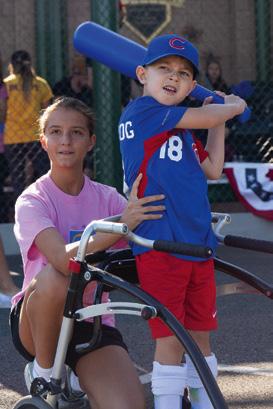











By Monique Seleen • Photos courtesy of Hope Haircuts
HOPE HAIRCUTS offers mobile in-home haircut services and a newly opened sensory-friendly salon environment for children and teens with special needs.
After working in a local salon for several years, Shirell Green, owner of Hope Haircuts, had developed a client base that included children with autism.
“I noticed mothers frequently felt embarrassed, misunderstood, and overwhelmed due to judgment when their kids cried or had a tantrum out of fear,” said Green. “This led me to establish Hope Haircuts in 2023, a safe haven for children, teens, and those with special needs in the Phoenix Valley.”
For in-home services, the stylists with Hope Haircuts will travel all around the Phoenix Metropolitan area—from Buckeye all the way to Gilbert—and are trained to handle haircut sensitivities by including short breaks and providing sensory toys like kid-friendly foam or

engaging light-up toys to keep them distracted.
“Our approach is entirely sensory-focused and never coercive,” said Green. “Our haircut sessions are tailored for young ones who may require additional time to get comfortable with the stylist and understand that it’s haircut day.”
In addition to in-home services, Hope Haircuts recently opened a sensory-friendly salon in Central Phoenix, which offers the same oneon-one environment for parents to bring their child for a haircut, for a fraction of the mobile cost.
“By offering an in-person option, we aim to reach out to more families with special needs, giving kids and teens a chance to experience the salon environment once more,” said Green.
Only one family is accommodated at a time in the center while someone is receiving a service, offering privacy and comfort for both the child and parent. The sensory-friendly environment is designed to feel like home, making the transition easier for current clients used to receiving services at home.
Additionally, the salon provides complimentary snacks and rewards after each session, with a variety of exciting toys and kid-friendly tools.
“We aim to create a welcoming environment for every sensoryfriendly family seeking assistance in helping their children or loved ones conquer any fears,” said Green. “Addressing the challenge of haircuts is a top priority, and we are dedicated to offering our support in every possible way. This journey is not just about physical appearances but an impactful experience. With continued visits, they will eventually find joy in haircuts, and those difficult moments will fade away.”
For more information or to book an appointment, visit hopehaircuts.com
By Ricky Denwood

RAISING A CHILD with special needs is a journey filled with unique challenges and incredible rewards. For fathers, the experience can be both profoundly fulfilling and overwhelmingly demanding.
Dads play a crucial role in their children’s lives, but they often face distinct struggles that require attention and support. Here are some reasons why dads of kids with special needs need support, and practical tips on how to provide it.
1 . Emotional Support is Crucial
Tip: Create a Safe Space for Sharing Feelings.
Dads, like all parents, need a safe space to express their emotions. Encourage open conversations where fathers can share their fears, frustrations, and joys without judgment. Support groups, like Dads Together, whether in-person or online, can provide a valuable outlet. Connecting with other dads who understand their experience can offer comfort and practical advice.
2 . Reducing Isolation
Tip: Foster a Supportive Community.
It’s essential to build a network of friends, family, and community members who can
offer support and companionship. Participate in community events, join local special needs organizations, and create an environment where everyone feels empowered.
3. Balancing Responsibilities
Tip: Share the Load.
Fathers often juggle multiple roles, it’s important to balance these responsibilities without burning out. Encourage dads to delegate tasks, share caregiving duties with their partners, and take breaks when needed. Professional help, such as respite care, can provide much-needed relief and time to recharge.
4 . Encouraging Self-Care
Tip: Promote Personal Well-being.
Self-care is essential for all parents, but it’s often overlooked. Encourage dads to take time for themselves, whether through hobbies, exercise, or simply relaxing. Regular self-care routines can reduce stress and improve overall well-being, making them more effective and present parents.
5. Fostering Strong Partnerships
Tip: Strengthen Relationships.
Raising a child with special needs can strain marriages and partnerships. It can be very helpful to have open communication, shared responsibilities, and quality time together. Counseling and couples’ support groups can also help maintain a strong, united front when facing challenges.
6. Advocating for Their Children
Tip: Be a Champion for your Child.
Dads need to be effective advocates for their children’s needs. Learn about your child’s rights, educational accommodations, and medical care options. Workshops, advocacy groups, and legal resources can empower fathers to navigate these systems and secure the best possible support for their children.
Supporting dads of children with special needs is not just about providing resources; it’s about building a compassionate community where they feel understood, valued, and equipped to face the journey ahead. By offering emotional support, fostering connections, and encouraging self-care, we can help these fathers thrive and, in turn, create a positive impact on their children’s lives.
By Arizona State Parks and Trails

DID YOU KNOW our state parks offer inclusive and accessible ways to have an adventure? Here are some highlights of fun and accessible recreation opportunities to explore in Arizona’s state parks:
Many trails within our parks are accessible for those who use wheelchairs or other mobility aids. Head to northeastern Arizona and learn about Hopi history at Homolovi State Park: the half-mile paved Homolovi II Trail leads to the largest of Homolovi State Park’s archaeological sites. In central Arizona, check out the world’s largest natural travertine bridge from the four accessible viewpoints at Tonto Natural Bridge State Park in Payson. Visiting Slide Rock State Park is more than just a dip in the water - take in the historic Pendley homestead and apple orchard, and the vibrant red rocks from the paved pathway and shaded overlook during off-seasons.
Find what works for your family by checking out the trails ahead of the trip! Arizona State Parks offers virtual, 360-degree views of each trail so that you can get familiar with the trail conditions before you visit. Visit AZStateParks.com, select the park you want to explore, and click on the Google Earth view.
Extend your outdoor adventure with a night under the stars! Camping cabins at state parks like Lyman Lake in the White Mountains, Lost Dutchman in Apache Junction, and Patagonia Lake in southern Arizona make camping a breeze, featuring entry ramps and nearby restrooms with roll-in showers.
Or, sign up for an Arizona Family Campout – a program offered by Arizona State Parks which provides all the equipment you’ll need for a fun weekend outside. Expert rangers and volunteers will teach the basics of camping as well as activities like kayaking, fishing, archery, and more.
The campouts are $90 for a family of four (open to children 6 years and older) and $5 per additional family member. Families who want to learn how to negotiate camping with a disability can sign up at least three weeks in advance and we will make any necessary arrangements.
Whether you want to catch some fish (and a memory or two!), or you want to dig your toes in the sand, there are lakes, rivers, and lagoons all around the state waiting to be enjoyed. Head to Dead Horse Ranch State Park in central Arizona to make use of the wheelchairaccessible fishing pier and boat ramp. Or plan a picnic with Colorado River views from the
shaded ramadas on Lake Havasu State Park’s beach – accessible via concrete pathways. Multiple parks even offer kayak, paddleboard, and other watercraft rentals, including Cattail Cove, Lyman Lake, Roper Lake, Patagonia Lake, and Lake Havasu state parks.
Every year, over 150,000 people of all ages and abilities experience the caverns. The trail system inside Kartchner Caverns is one of only a select few that was developed specifically to provide an exceptional experience for people with limited mobility.
Access to parking areas, campgrounds, picnic areas, buildings, and restrooms were designed to be wheelchair accessible. A wheelchair-accessible tram transports you from the Discovery Center to the cave entrance, where 2.5-miles of paved pathways transport you through the cave and past astonishing formations.
Detailed information on this special experience from the team at Ability 360 can be found at AZStateParks.com/Kartchner.
To learn more information about access for people with disabilities, or to send in accessibility comments or questions, please contact Arizona State Parks and Trails at 602-542-4174 or email access@ azstateparks.gov







K-12 TUITION-FREE PUBLIC CHARTER SCHOOLS WITH QUALITY PRE-K PROGRAMS
High quality academics in a moral and wholesome environment
Entrepreneurship and Dave Ramsey
financial literacy courses
State-of-the-art athletic facilities
Full K-12 experience featuring fine arts programs including ballroom dancing, choir, theatre, and orchestra

